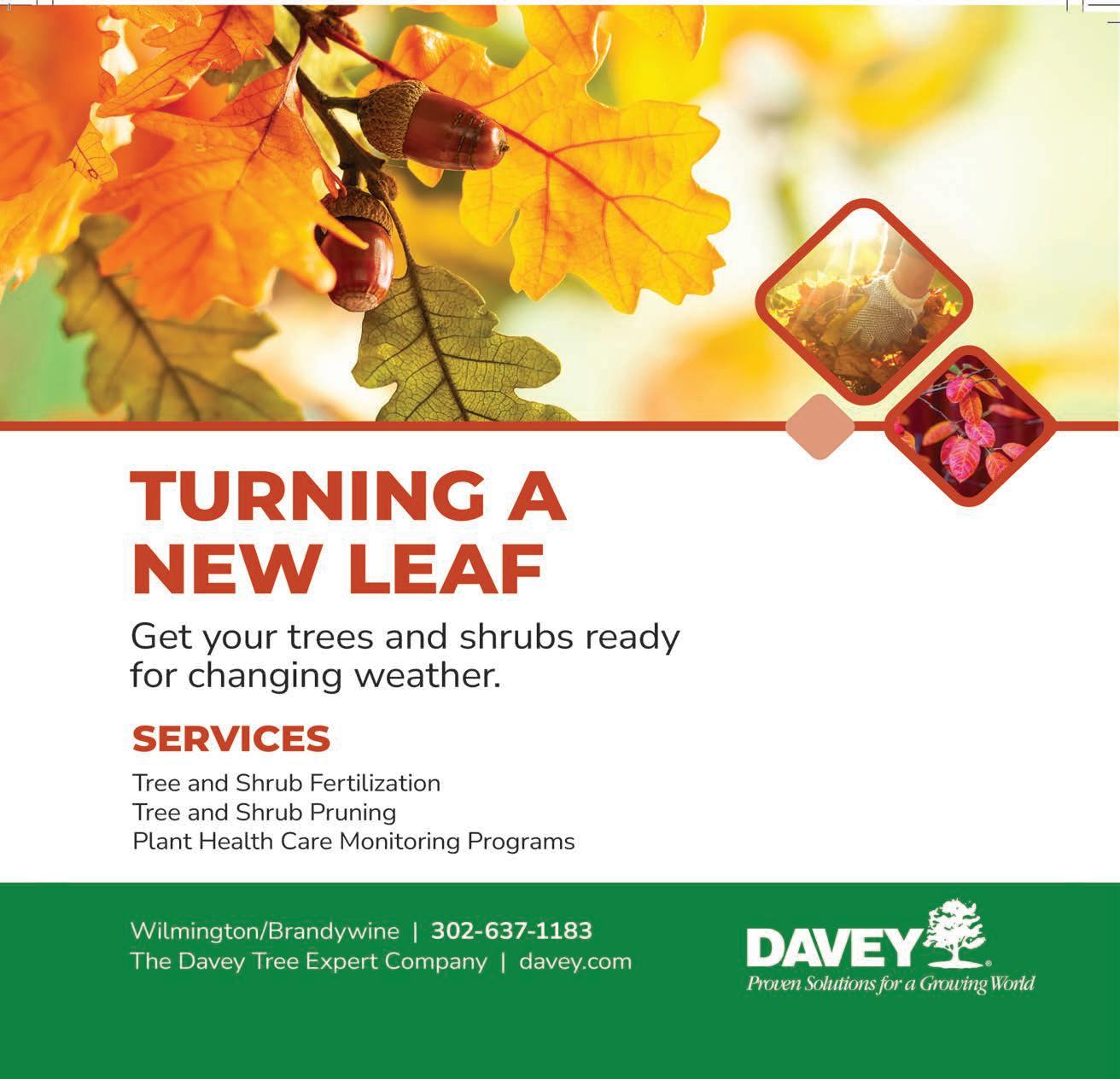

Newark Life
Newark Life Magazine
Photographer Christina Peters
Creating art that the eye will never see Page 46
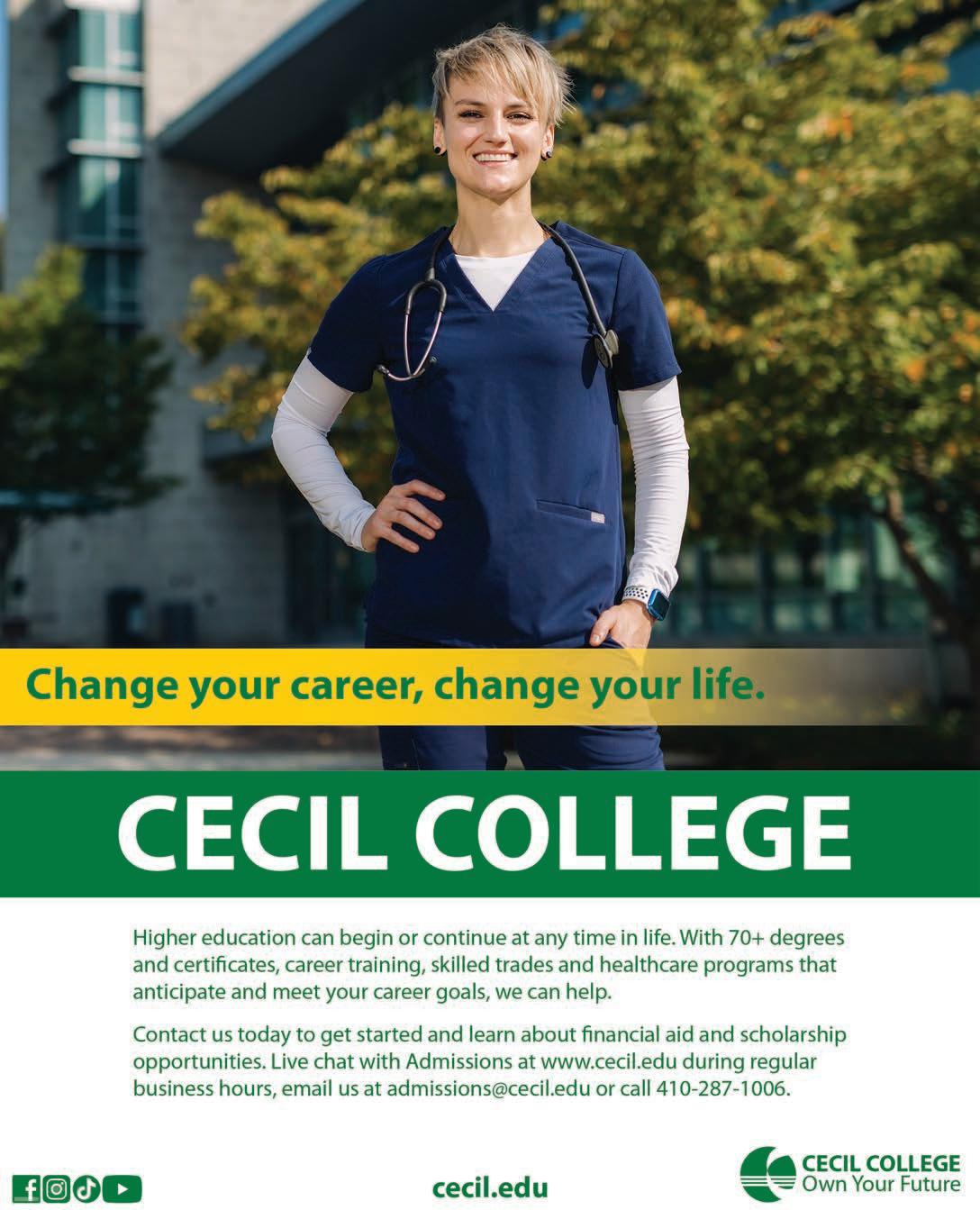









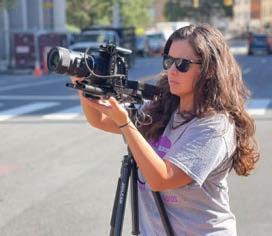
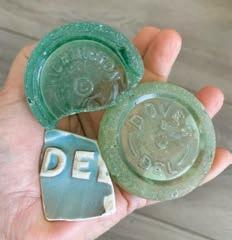
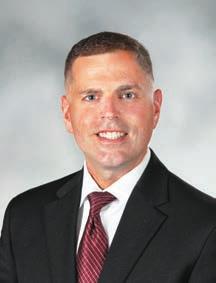

Newark Life Fall/Winter 2025
Letter from the Editor:
Welcome to the Fall/Winter issue of Newark Life.
In this edition, writer Ken Mammarella introduces readers to Gina Olkowski, who uses sea glass to make a wide variety of artistic creations. Sea glass is glass smoothed by rocks, sand and waves, a process that she said takes 30 to 100 years. Olkowski has accumulated hundreds of pounds of sea glass that she has found, bought and been given so that she can use the sea glass to create art.
We also introduce you to Steven Leech, who has been referred to as “Delaware’s pre-eminent man of letters.” Leech became a multimedia creator decades before the concept became common. In 1959, he wrote his first story. In 1984, he produced 13 radio programs that constituted the first broadcast edition of Dreamstreets, a magazine that had begun in 1977 to showcase local progressive artists, photographers and writers. In 1989, he started a radio show.
With one critically acclaimed film now available and another one in pre-production, Newark-based filmmaker Bella Dontine is at the absolute center of her life’s story. From the time she was a young child growing up in Wilmington, Bella Dontine’s life has been a tireless pursuit of hers to find, confirm, solidify and protect her authentic self. For the past three decades, her ‘to thine own self be true” journey has been clearly visible to anyone who wishes to see it: on stage in musicals throughout Delaware, as a singer-songwriter on Instagram video snippets and most especially in her films.
Over his long and distinguished career with the New Castle County Division of Police, where he is now a Senior Lieutenant, and his time on Newark City Council, Travis McDermott has made his mark as a public official. On April 17, he took on his largest role yet as Newark’s newest mayor. Recently, Newark Life met with Travis to discuss what he sees as the city’s top priorities, his long-term vision for Newark and his very unique dinner party guest list.
We also feature a story about Babita Jagnanan’s operations that aim to reduce waste and establish futures. After almost 17 years working for someone else in secondhand textile recycling, she decided to go out on her own. In 2019, she founded the for-profit Phoenix Used Clothing, which “focuses on the reuse and recycling of textiles in support of local communities throughout Delaware,” according to https://phoenixusedclothing.online. In 2022, she founded Phoenix Family Resources, a nonprofit dedicated to “ensuring everyone has access to the resources they need to thrive.”
The photo essay in this issue highlights the work of photographer Christina Peters. When she was eight years old and living in Newark, her father, a chemist, gave her a plastic camera. By the time she turned ten, he taught his daughter to properly use his Minolta XT 101. Peters has gone on to be a commercial and food photographer for more than 30 years.
We hope you enjoy the stories and photos in this issue of Newark Life and, as always, we welcome your comments and suggestions for stories to highlight in the future. We’re already hard at work on planning for the next issue of Newark Life, which will arrive in the spring of 2026.


Sincerely,
Avery Lieberman Eaton averyl@chestercounty.com
Stone Lieberman stone@chestercounty.com
Steve Hoffman, Editor editor@chestercounty.com
Cover design: Tricia Hoadley
Cover photo: Jim Coarse
Art from the Art from the
Gina Olkowski features sea glass in Gina Olkowski features sea glass in


Photo by Ken Mammarella
Gina Olkowski makes art out of sea glass and other beachcombed items.
the ocean the ocean
in flowers, cats and other creations in flowers, cats and other creations
By Ken Mammarella Contributing Writer
Among the supplies that artist Gina Olkowski has sorted in her home studio just south of Newark are cat tails and ears, white petals and the letters needed to spell “love.” They’re among the hundreds of pounds of sea glass that she has found, bought and been given.
Sea glass is glass smoothed by rocks, sand and waves, a process that she said takes 30 to 100 years. Pieces that have been in the water longer are often eroded into tiny, useless bits, like the sand that they had once been. Pieces that have been in the water less time are not considered “cooked” or “done.”
Sea glass is most commonly brown, clear and green, because those are the most common colors for bottles. Exceptions include gray (such as TV screens), cobalt blue (Bromo Seltzer bottles, perhaps made in Baltimore), pieces made with manganese (once clear, but turning lilac in the sun) and multicolored pieces (discards from the glassmaking studios in Murano, Italy).

She uses the pieces as she finds them, except for drilling holes in them so that they can be hung. She maintains that standard to get into the juried festivals where she sells most of her creations. She also promotes her work as Saltwater and Sand on Facebook and Saltwater.and.sand on Instagram.

Olkowski was young when she first started looking for sea glass with her family while at her grandmother’s house in Seaside Heights, N.J.
“I remember being excited by finding a good piece, like a big one or a blue one, because blue is a rare color, and big things get broken,” she said, “and I still get excited when I find a well-worn piece that I can use in my art.”
She has collected a lot along the Jersey Shore, but beach replenishment after Hurricane Sandy buried the good stuff, she said. She and her husband Greg are quite familiar with the “sea glass stoop” needed to walk along the beach and look down for sea glass.
“I take vacations to find sea glass,” she said, citing trips to Italy, Greece, Barbados, Puerto Rico, Curacao and St. Croix.
Continued on Page 12
Photo courtesy of Gina Olkowski She also makes bowls out of sea glass.
Art from the Ocean
It began with a fundraiser
Olkowski moved to Delaware for college, and she retired in 2017, after a career of mostly teaching science and math at Redding Middle School in Middletown. She now works part-time at St. Anthony of Padua Grade School in Wilmington, providing extra support in reading and math.
Her work as an artist began about 15 years ago when she made a piece out of scallop shells for a fundraiser

Continued from Page 11 for the wrestling booster club at St. Mark’s High School, where her son Michael was a student.


“Shells were easier to find,” she said. “I wasn’t ready to give up my sea glass.”
Now she is.
Her studio occupies most of one bedroom, with supplies spilling over to other parts of the house. The glass is sorted primarily by color, but also size of the pieces, where she found them and their potential purpose. Purposes include popular themes, such as snowmen (calling for white circles of various sizes), Christmas trees (green triangles) and the white flowers that are her most popular designs (popular is relative, she said, noting that sea glass appeals mostly to people with beach houses).

Photo by Greg Olkowski Beach combing in Barbados.
Continued on Page 14
Photo by Ken Mammarella
Olkowski keeps her first sea glass creations on her studio wall.
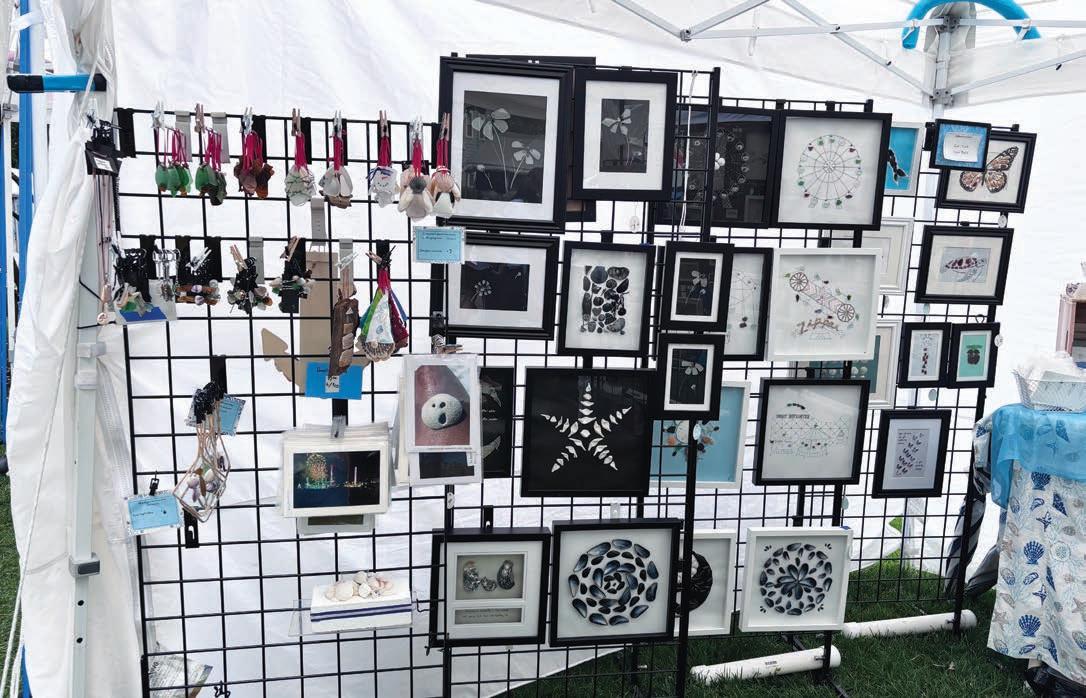


Photo courtesy of Gina Olkowski Olkowski’s most popular pieces are white flowers, with the petals made out of sea glass, such as the ones at the top center of the display.

Art from the Ocean
Continued from Page 12
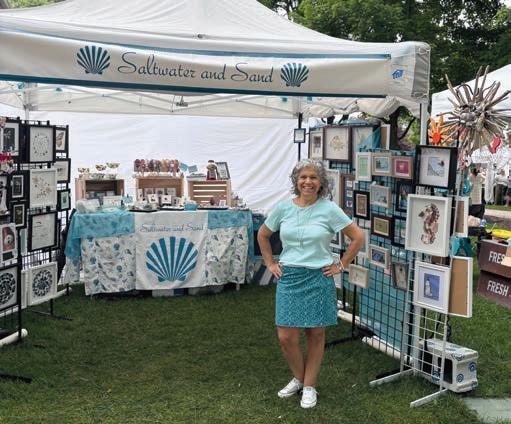
She also collects seaweed, sponges, crab molts, sea stars, seahorses, horseshoe crab molts, fish vertebrae, driftwood, pottery, bricks and shells. A favorite nearby spot now is along the Delaware River in Old New Castle.
“It’s a mix of old glass and trash, so you have to be discerning,” she said, noting the trash can include false teeth and eyeglasses. Another form of trash, for her, is craft glass – pieces manufactured to look like sea glass. And she doesn’t paint or polish pieces, as some people do.
Katie Skeels, a friend since kindergarten, fondly recalls joining Olkowski to collect sea glass when they were young. Skeels’ family also enjoyed collecting sea glass, and after Olkowski started making art with it, Skeels gave her several mason jars filled with sea glass.
“Take it, create your art and share it,” Skeels recalled saying.


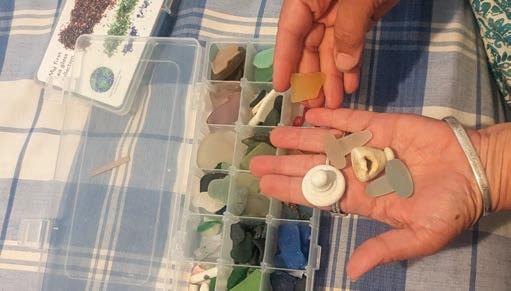
Photo courtesy of Gina Olkowski Olkowski has an extensive wardrobe in sea foam for promoting her Saltwater and Sand brand at festivals.
Photo by Ken Mammarella Olkowski displays her glass stoppers.
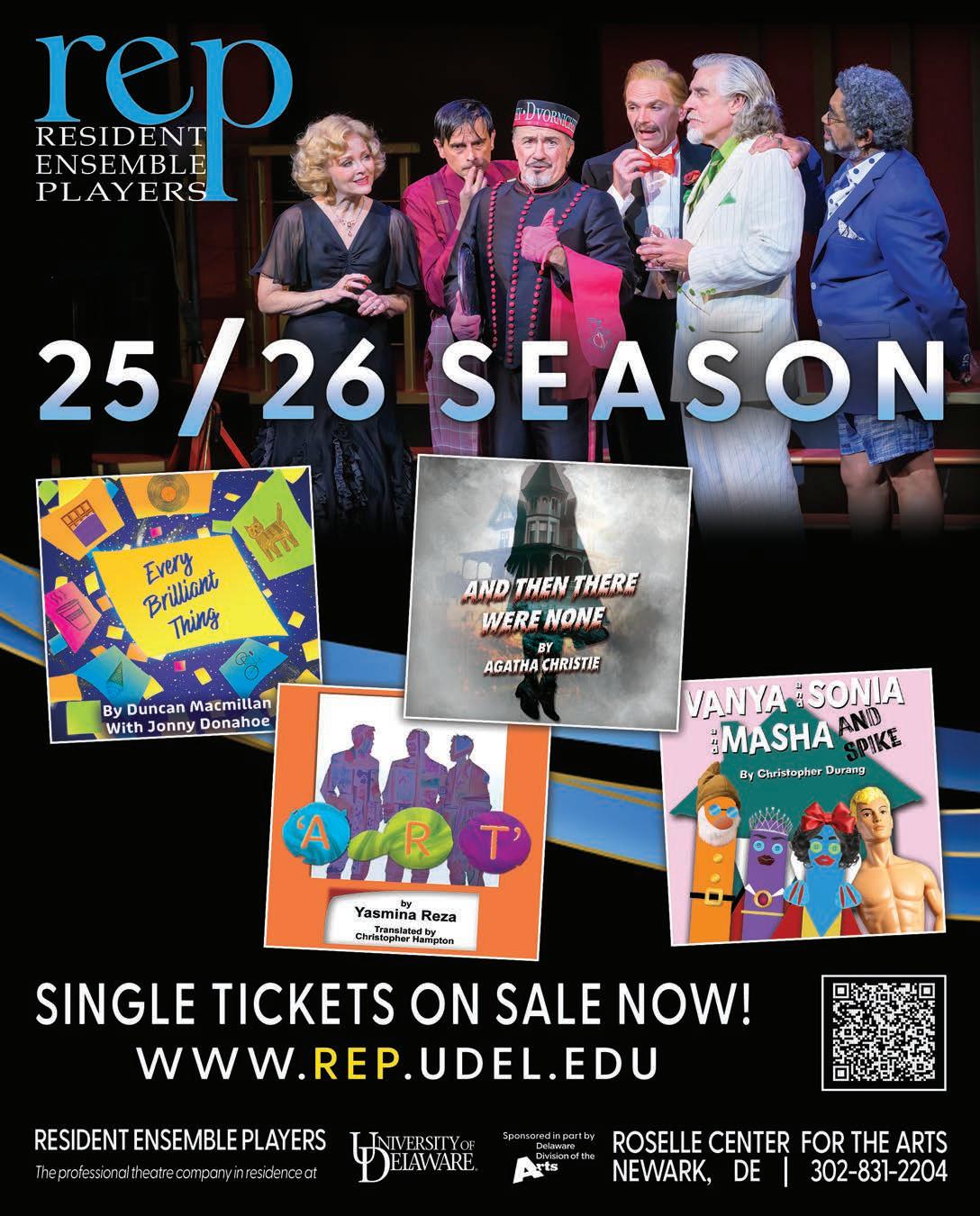
Art from the Ocean
Continued from Page 14
A multifaceted artist
Olkowski has made multiple pieces for Skeels and her family, and probably the most treasured is one that depicts the nine grandchildren of Skeels’ mother, she said.
“Gina is a multifaceted artist – she is an actress, costumer, and visual artist,” said Gail Wagner, who has acted with her and directed her on both stage and in film. Olkowski’s credits include independent movies, training films, commercials and theater productions at Chapel Street Players, the Wilmington Drama League, Reedy Point Players and the Milburn Stone Theater.
“When Gina began to create her natural sea glass pieces, they made me think of stained glass windows as well as warm weather, summertime, and, of course, the beach,” Wagner said. “Gina creates not just the whimsical, but the memorable. My purchases from Gina are framed pieces which were created for me personally as well as gifts for family.
“My first purchase was a custom picture representing the three dogs we had at that time. She even drew a line behind one of the pieces of glass to represent the ridge running down my Rhodesian Ridgeback’s back.
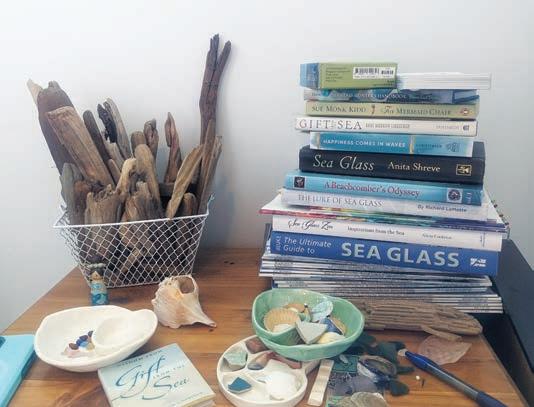

“Second is the Delaware-shaped sea glass picture. A special art piece for any native Delawarean. Gina made a custom gift for my son and daughter-in-law of a sea glass dog picture of their dog, and my other son received a Star Wars-themed sea glass picture. Each gift was loved!
“Gina doesn’t just work in sea glass, but also natural shells gathered from the shoreline from which she creates pictures, trinket bowls and tiaras. Each one is a special reminder of a day walking the beach, hearing the surf, putting your toes in the sand.”
Continued on Page 18


Photo by Ken Mammarella Sea glass is popular enough to spawn magazines, books and color guides.
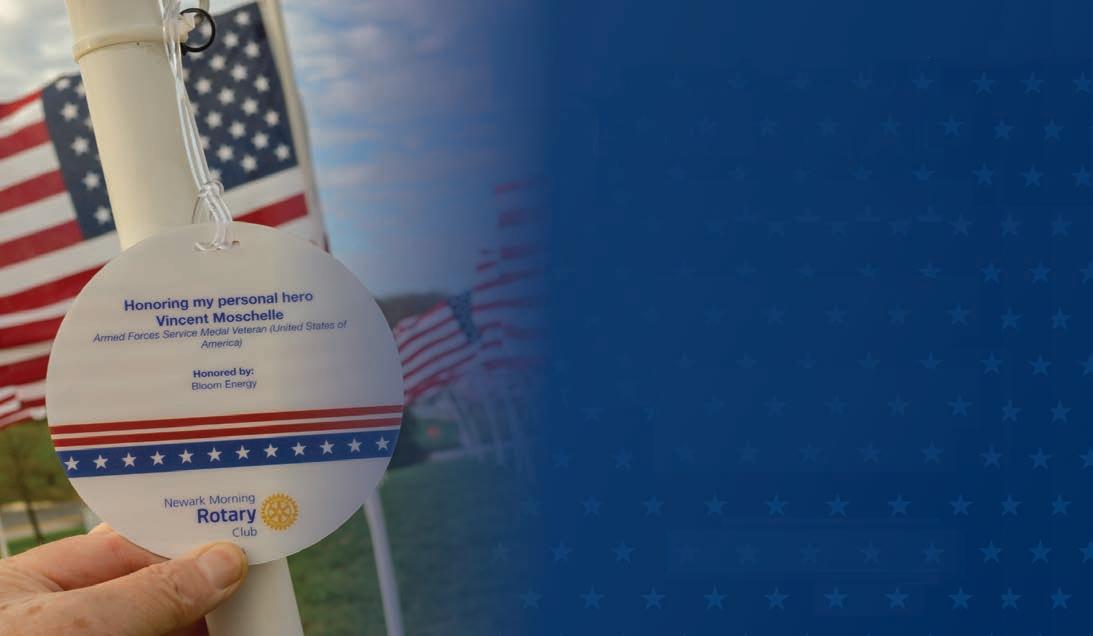

Your hero’s personalized medallion will be yours to keep (and share) after the ceremony. All proceeds support local hero causes (Veterans, First Responders, & Healthcare).



Continued from Page 16

“People interested in finding sea glass [should] look on rocky beaches because the rocks help weather the glass and keep them from being swept back out to sea,” Delawareonline.com wrote in 2024. “It’s best to wait for low tide when more of the shore is exposed.”
That post and posts on OnlyInYourState.com and Reddit.com recommend these Delaware areas: Big Stone Beach, Bowers Beach, Cape Henlopen, Pickering Beach and Woodland Beach.
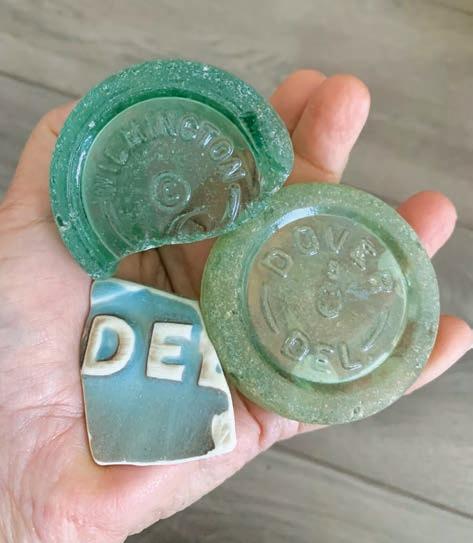
Photo courtesy of Gina Olkowski

‘Delaware’s pre-eminent man of letters’
Steven Leech is known for his work as a writer, editor and radio host
By Ken Mammarella Contributing Writer
Steven Leech became a multimedia creator decades before the concept became common.
In 1959, he wrote his first story. “I was curious about a lot of things,” he explained in an interview, adding that writing has also helped him “get rid of stuff” and “exorcise demons.”
In 1984, he produced 13 radio programs that constituted the first broadcast edition of Dreamstreets, a magazine that had begun in 1977 to showcase local progressive artists, photographers and writers.
In 1989, he started a radio show. “Even Steven’s Boptime’ mixes music of the ’40s, ’50s and ’60s: bebop, hotbop, cool school, R&B, pop, rock ’n’ roll, according to WVUD - the University of Delaware’s radio station - which has also installed him in its Hall of Fame.
The radio show is still a fixture on Saturday mornings from 6 a.m. to 10 a.m., in partnership with co-producer Larry Williams. The programs go beyond music, Leech said, to include deeper messages on social issues and radio dramas.
Dreamstreets – which has also sponsored monthly poetry readings, had a video element and created more radio programs – published its 83rd issue this summer. Leech is the executive editor.
But after 600 articles and 10 books, he’s stopped writing. “I’ve written everything I have to say.”
Continued on Page 22

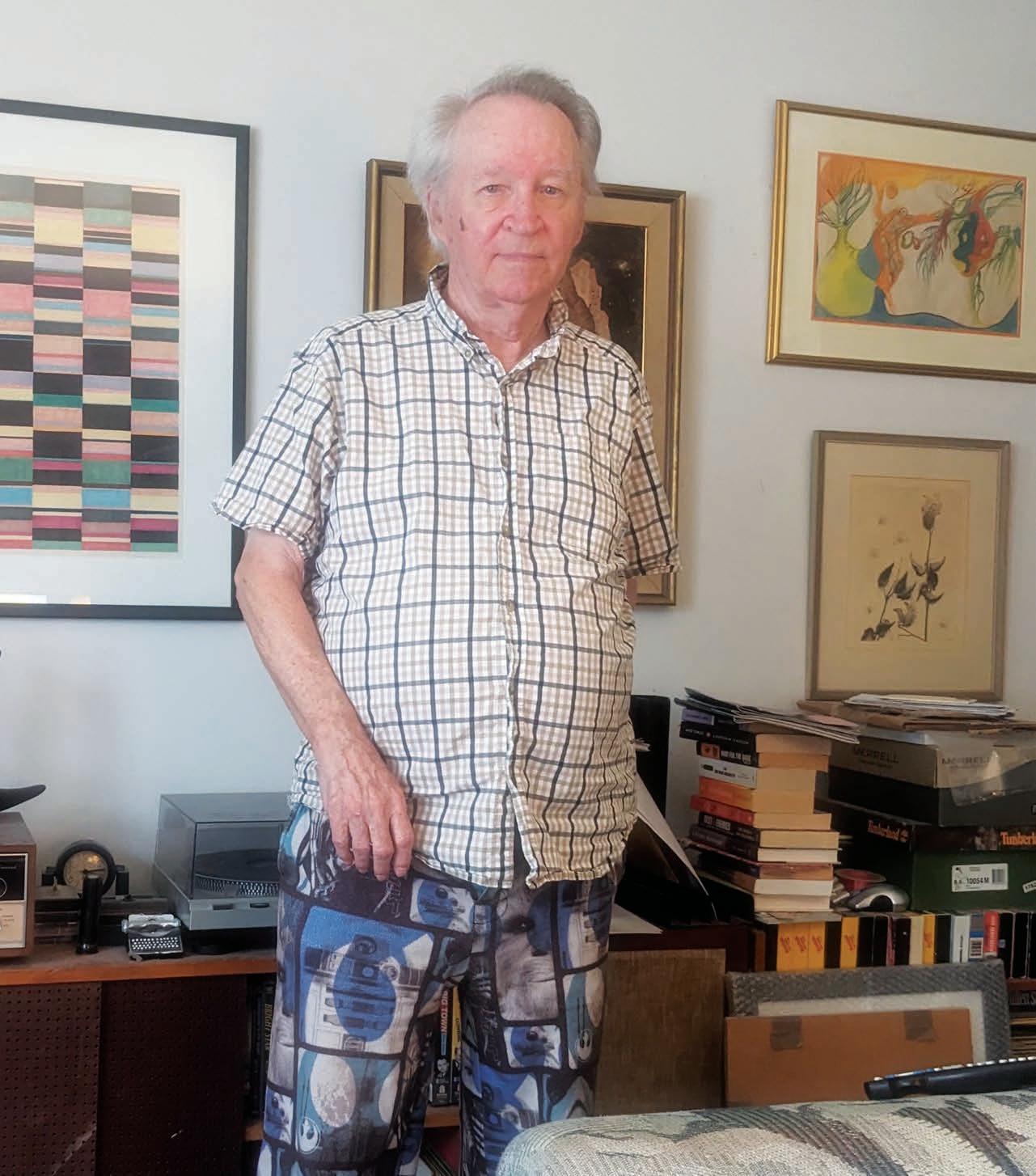
Photo by Ken Mammarella
Lots of art decorates Leech’s apartment, including a work on his right by his sister Nina.
Continued from Page 20
|Newark Life|
A
personal portrait
Leech’s family goes back generations in Delaware, including the great-grandfather who lent his name to Leech Avenue in Elsmere. He entered the working world as a paperboy, soda jerk and retail clerk. After graduating from Conrad High School (now Conrad Schools of Science), he started studying philosophy at Wesley College (now part of Delaware State University). He was trying to transfer to the University of Delaware when he was drafted by the Army in 1966.
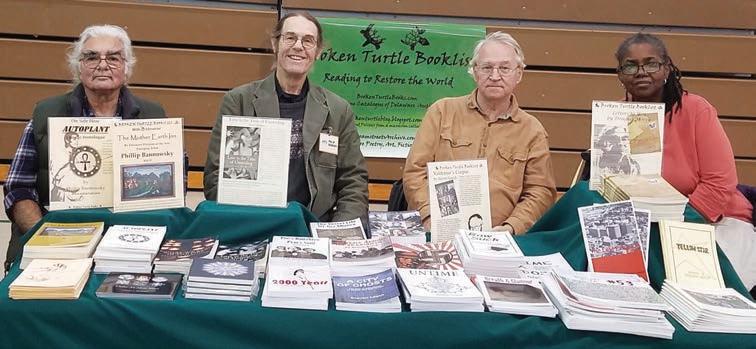
He returned from his tour of duty in Vietnam in 1968, the week that martial law was declared in Wilmington, following riots sparked by the assassination of Martin Luther King Jr. “I came from one war zone to another,” he recalled. “That was a big turning point.”
Leech shed his right-wing beliefs to protest the war and


injustice, and he also connected with people trying to combat what he called the state’s “cultural wasteland.” Part of that involved editing a UD publication called Viewpoint that wrote about black history and “radical feminists who hadn’t talked to a man in years.” He graduated from UD in 1974, with a major in English and minor in history.
Continued on Page 24





Photo courtesy of Phillip Bannowsky
Douglas Morea (from left), Phillip Bannowsky, Leech and Franetta McMillian founded Broken Turtle Books and form the current editorial staff of Dreamstreets. The photo is from the 2017 Hockessin Book Fair.


Steven Leech
Continued from Page 22
Over his decades of work, he’s only had one job with benefits, driving a school bus in the Newark area from 1973 to 1998. Since 2003, he’s worked on and off as a UD Library stacker, returning borrowed books and keeping the stacks organized.
Here’s how he describes himself to readers: “Steven Leech currently lives in a cramped apartment in a modest and aging apartment complex within the suburban sprawl between Wilmington and Newark, Delaware. It is here that he not only staves off poverty but enjoys the infrequent company of a few good friends, constantly processing to manage the psychic pain from lifelong PTSD, conjures new contributions to the local cultural environment, strives to gain a better understanding of the world and cosmos around him, and communes with the ineffably divine spirit dreaming in every sentient being.”

Photo courtesy of Phillip Bannowsky “I have a thing about literary history,” Leech said.
Informed by the past
“Steve Leech is a treasure trove of knowledge on both the literary and musical fronts,” said Williams, a musician, saxophonist, composer, arranger, music historian, record collector, part of a jazz ensemble called Keepers of the Flame and board member of the Delaware Rock & Roll Society.
Williams has joined Leech for more than 200 programs called “Clifford’s Corner,” in honor of Wilmington jazz legend Clifford Brown.
“Our first hour is devoted to jazz, the second to R&B. … We talk about the music we play and try to educate our listeners as well as playing songs that they may have never heard, or haven’t heard in a long time,” he said.
“I learned quite a bit about the history of jazz in Wilmington from Steve. Besides that, he’s a great friend, and we work well together. A number of records that I have in my collection today are things I first heard on ‘Boptime.’
Continued on Page 25
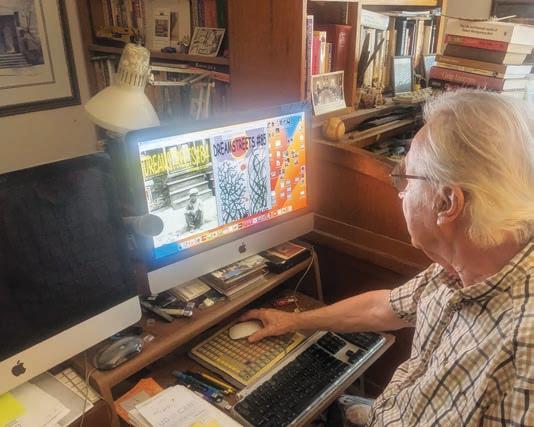

Photo by Ken Mammarella
Steven Leech with some of the equipment and books that he uses to work on the literary magazine Dreamstreets and “Boptime,” a WVUD program.
Steven Leech
Continued from Page 25
… Being on the radio with Even Steven is a blast.”
Leech’s written works, his selections for “Boptime” and content in Dreamstreets often involve Delaware’s literary past.
“I have a thing about literary history,” he said. “There are a lot of us who are writing today who don’t realize, don’t want to be or don’t even think about being part of a historical legacy.”
And he knows that legacy well, drawing upon his large personal library, his work in cataloguing and archiving for UD and the Delaware Historical Society and other research.
His fiction includes “Poe’s Daughter, Pym’s Soul: A Gothic Tale of the Antebellum Mid-Atlantic” and “The Secret Life of Tux Munce,” which he calls “a speculative history of northern Delaware” featuring real people like novelist F. Scott Fitzgerald, who lived in the state from 1927 to 1929.
Leech’s nonfiction includes “Boysie’s Horn: The History of Jazz in Wilmington in the 20th Century” and “Valdemar’s Corpse: Exploring the History of Delaware’s Literary Art.”
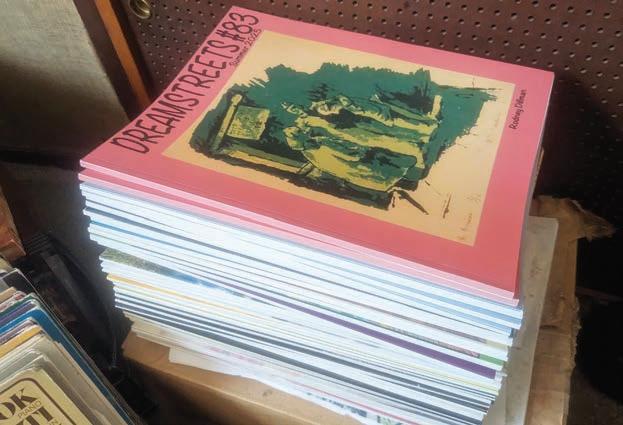
“In ‘Valdemar’s Corpse,’ the story of Delaware’s literary legacy is allowed here to speak, however briefly, from its academically imposed deathbed before returning to cultural amnesia,” he wrote early in the book.
Continued on Page 28

Photo by Ken Mammarella Leech is the executive editor of Dreamstreets.


Steven Leech
Continued from Page 26
Connections
Dreamstreets today exists almost entirely online (www. dreamstreetsarchive.com), with on-demand hard copies available on www.blurb.com, the same website that Leech uses for his own books.
Leech likes each issue to feature “something historical, some good poetry, some fiction, some interesting art.” Producing it is a labor of love.
“No pay, no budget,” he said. “Everything is sweat equity.”
Working with him are Phillip Bannowsky, Douglas Morea and Franetta McMillian. The first three are all in their 80s, with McMillian two decades younger.
“I have often joked two-thirds seriously that Steven Leech, author, editor, radio host, and retired school bus driver, is Delaware’s pre-eminent man of letters,” Bannowsky wrote in 2011, when he was recommend-
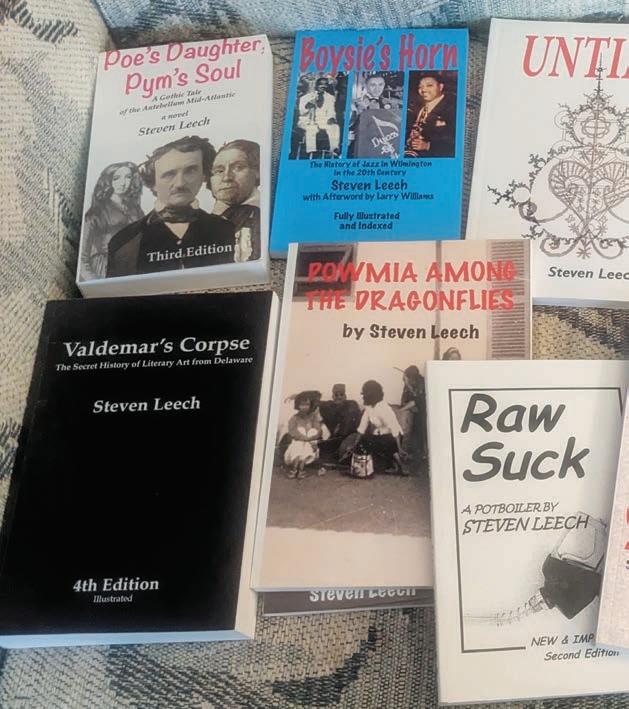
ing him for a Guggenheim award. “Frugally and at great personal sacrifice, Leech has breathed new life into the rich legacy of popular and literary culture in a small state laboring against enormous institutional inertia.”
Bannowsky, who has known Leech since 1968 and was Leech’s editor for “Boysie’s Horn,” said that “Leech’s style and content are of a character outside the mainstream and the well connected. His personal literary work is ... at times deeply, painfully personal and at times adventurous and prophetic.”
Thanks to modern technology, Leech can produce content for his radio show and Dreamstreets from his home, where he feels safe.
“I don’t want to be hurt, and I don’t want to hurt others,” he said about his preference to stay at home. “I’m a recluse.”
has written 10 books, both fiction and nonfiction.


Nicole J. Bright, D.O.
Howard L. Brooks, MD
Gina Caputo, D.O.
Shannon Husebo, PA-C
Drew Venables, PA-C
Michele Kassien, NP
Accepting New Patients
Photo by Ken Mammarella Leech
Where textiles, and lives, are reborn
Babita Jagnanan’s operations aim to reduce waste and establish futures
By Ken Mammarella
Contributing Writer
Babita Jagnanan says that she loves to talk trash, and she does more than just talk about it.
After almost 17 years working for someone else in secondhand textile recycling, she decided to go out on her own. In 2019, she founded the for-profit Phoenix Used Clothing, which “focuses on the reuse and recycling of textiles in support of local communities throughout Delaware,” according to https://phoenixusedclothing. online. In 2022, she founded Phoenix Family Resources, a nonprofit dedicated to “ensuring everyone has access to the resources they need to thrive.”
“When I started in the textile industry as an administrative assistant, I became fascinated with it from an environmental standpoint and how much waste is going into the landfill,” she said.
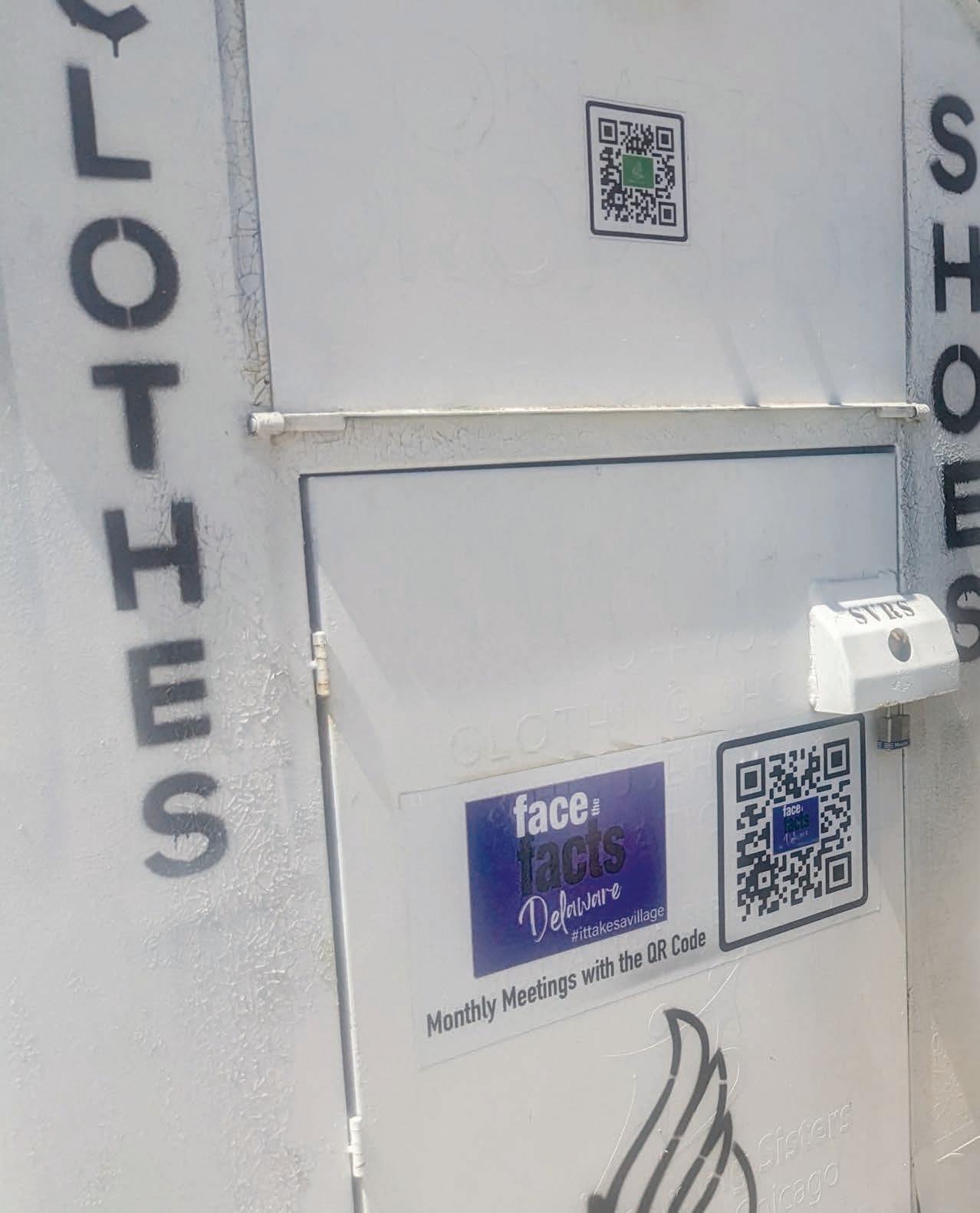
Jagnanan’s goal is to reduce that waste via textile recovery, reuse and recycling. For every 100 pieces of clothing sold each year in the US, 85 pieces – bought that year or before – are trashed, she said.
Phoenix collects items that are often given free to the “displaced,” she explains in a video on the company website. That includes those living in encampments, those “getting out of transition housing to start over a new life, or to someone who just needs a new pair of sneakers.”
Phoenix Family Resources moved in 2024 from Newark to the campus of Holy Spirit Roman Catholic Church near New Castle.
“This is awesome,” said Carla Davis, a Red Clay staffer on her first trip to Phoenix, chaperoning students from Meadowood, a Red Clay School District program for intellectual and developmental disabilities. “I had never even heard about this place, and I’m really impressed. It’s a great chance to help.”
Continued on Page 32
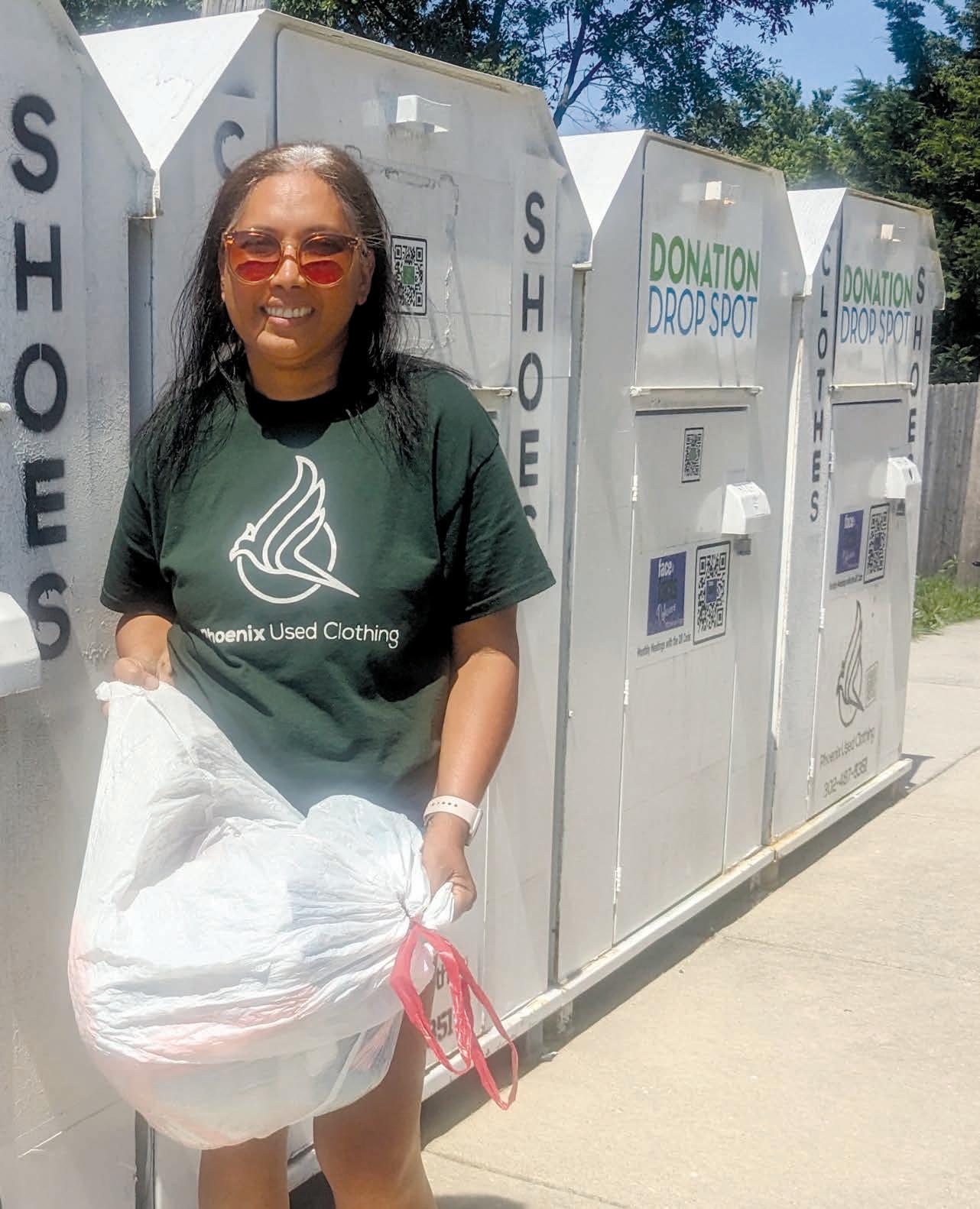
All photos by Ken Mammarella Babita Jagnanan is the founder of Phoenix Used Clothing and Phoenix Family Resources, which combine to collect donations in 42 bins across New Castle and Kent counties, sort donations in a space in Newark and give away clothing and other items in a space near New Castle.
Phoenix Used Clothing
Continued from Page 30
‘And she delivers’
From a donated Newark facility, Phoenix contracts with people – 90 percent in recovery from substance abuse – to grade items and sort them into 20 categories. What Phoenix can’t use is sold as rags, which generates enough income each year to pay about 10 contractors and Jagnanan herself.
“We are committed to honoring every textile we receive,” Jagnanan said. “Items that aren’t suitable for direct redistribution are responsibly recycled –repurposed into industrial wiping cloths or other textile reuse streams – helping reduce waste and keep clothing out of our landfills. This process supports our environmental mission while ensuring that nothing goes to waste in our pursuit of dignity, sustainability and community care, with a primary goal of achieving zero waste.”
Continued on Page 34
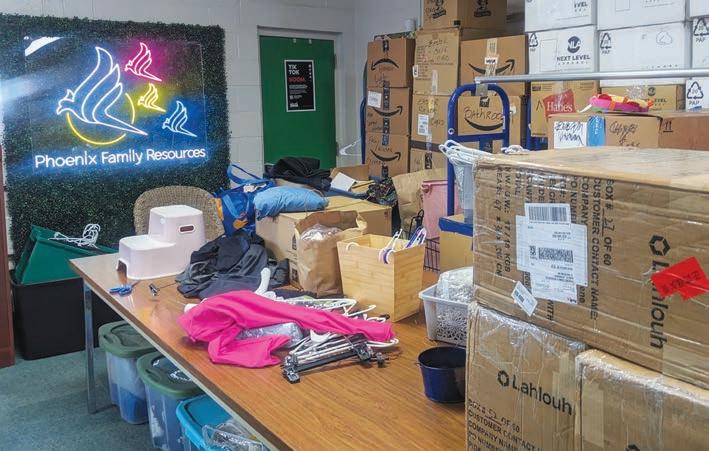


Phoenix gets donations from multiple sources, and Jagnanan also goes online to snare bargains.
Music Director


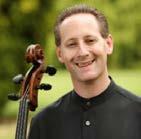


Featuring the 2025 Youth Concerto Competition Winner The Independence School, Newark October 26 3pm November 8 7:30pm December 7 3pm
Featuring soloists Marjorie Sheiman & Lawrence Stomberg
The Independence School, Newark
Featuring clarinetists Joanna Wiltshire, Michelle Webb, Tom Trinter, and Stirling Bowlick | Newark United Methodist Church
Featuring soloist Ira Rodrigues
The Independence School, Newark
Jewish Heritage Concert Chamber Concert A Holiday Concert Chamber Concert
Celebrating Șerban Petrescu’s 20th year as Concertmaster Newark United Methodist Church
Simeone Tartaglione,
Phoenix Used Clothing
Continued from Page 32
Phoenix Family Resources’ store – where it’s all free – is open 9 a.m. to 1 p.m. Mondays through Thursdays and by appointment the rest of the week. Most people make an appointment.
“We built this space with one purpose – to make it easier for caseworkers and their clients to get what they need without the runaround,” Jagnanan said. “Whether you come with a client or send them to us, know this: we’ll meet them where they are. No judgment, no red tape –just dignity, compassion and a place that sees the whole person, not just the need.”
“If they need anything, I send them to Babita,” said CJ Colburn, an outreach specialist with Community Collaboration of Delaware, whose office is across the hall from Phoenix. “And she delivers.”
“What can I say about an organization that I can send one or 100 people there to be helped? Babita and Phoenix Family Resources turned no one away,” said PennyAnne Badders-Rogers, executive director of Face the Facts
Delaware, noting that the organizations have together furnished “tons of recovery residences. … And then she takes it from there and gives them every textile they need. Curtains, carpets, bedding, blankets, spatulas, dishes, you name it. She’s got it. She takes their houses and makes them into homes. Face the Facts is so incredibly grateful to have her and Phoenix Family Resources as community partners.”
Jagnanan relies on being given items in bulk (like the 10,000 pairs of Bombas socks she receives annually), getting items from other nonprofits (from places like Chester Bethel United Methodist Church, which twice a year clears its thrift shop; Table of Plenty Delaware; the Center for Neighbors in Need at the People’s Church of Dover; and Habitat for Humanity of New Castle County) and collecting donations from 42 bins in Kent and New Castle counties (the bins themselves are recycled, too). She also scours the web for bargains.
Continued on Page 36
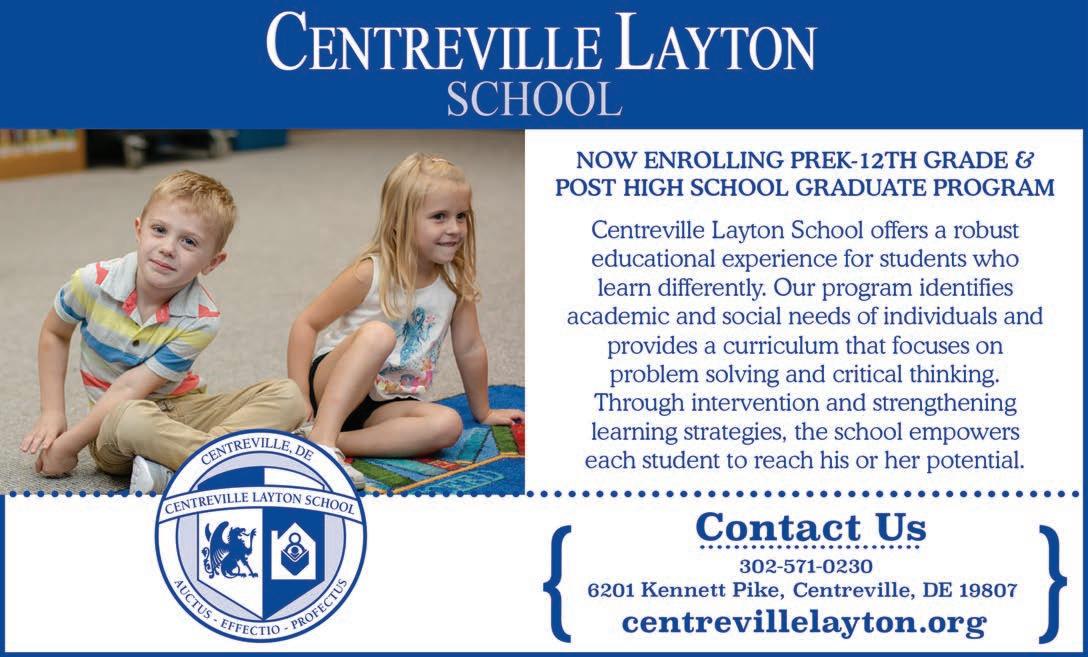
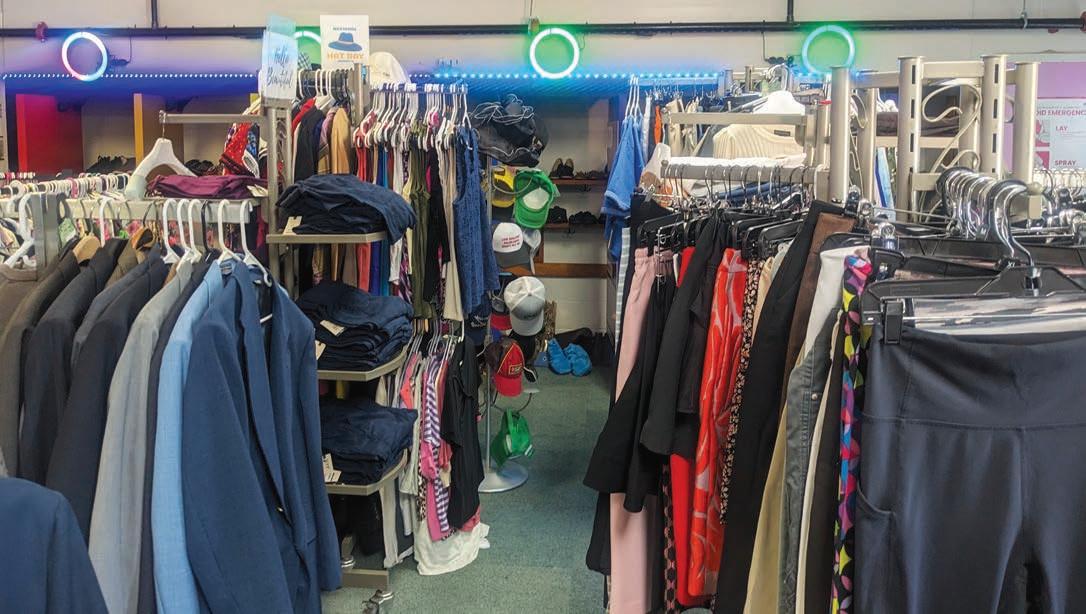
Phoenix started as an environmental project to reduce goods entering landfills. It now does much more.


Phoenix Used Clothing
Continued from Page 34
61,636 families helped in 2024
In 2024, Phoenix Family Resources distributed goods valued at $7.4 million to 61,636 families state-wide, according to its annual report. To “combat the opioid crisis and support public health,” it trained 16,683 people to administer Narcan and distributed 139,678 pieces of harm-reduction products, including wound-care kits, safer-sex kits, syringe exchange supplies and other critical items.
Phoenix helps out where it can and connects people to other places to address multiple societal and economic issues, such as food insecurity (not having enough food, particularly nutritious items), treatment services for substance abuse, harm reduction access to housing and period poverty (not having menstrual supplies).
“Through contributions from individuals and partners, Phoenix regularly fills requests for clothing and backpacks for school children, baby supplies for new parents,
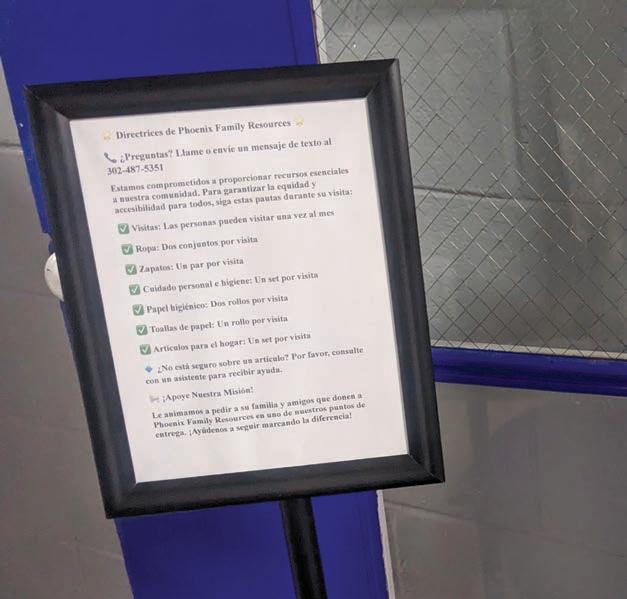

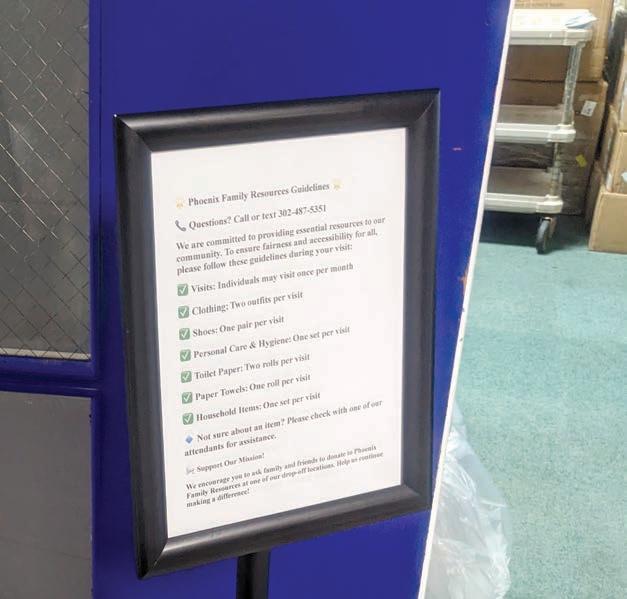
coats and blankets for the unhoused, bedding and basic appliances for those in substance-use disorder abatement programs,” according to phoenixfamilyresourcesde.org. Phoenix also packs items for the Hope Center, a New Castle County facility offering housing and support for people experiencing homelessness.
“If you ever walk around in the substance-abuse world, you don’t realize how many people just need a little bit of help to get their lives back together,” Jagnanan said. “Eighty-five percent of textiles end up in the landfill each year, yet so many people do not have access to proper clothing, which is a human right.”
That impact sinks in to people served (“A lot of our guests that get clothing from us come back and stay as volunteers to help pay it forward”), to her family (daughter Jasmine Clough works there) and to herself.
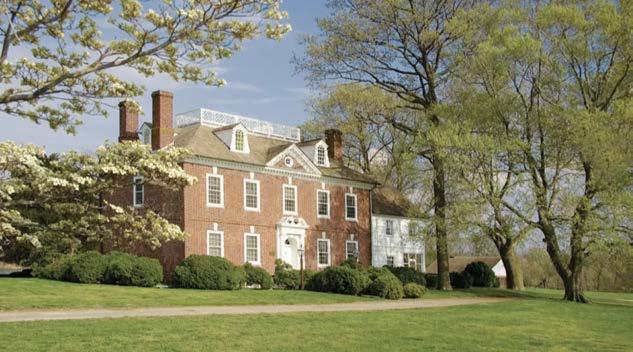


Phoenix Family Resources operates a store where all the items are given away to the needy.
Mount Harmon, a scenic & historic treasure.
Phoenix Used Clothing
“After graduating college, I was searching for my path,” Clough said. “I’ve always been my mom’s volunteer, watching her lead Delaware’s first woman-owned textile recovery facility with heart and hustle. After we lost our dad, I chose to stay on at Phoenix. I coordinate pickups, support the resource center, handle admin work – and help wherever I’m needed. My mom showed me that purpose and impact can go hand
in hand. Through Phoenix, I’ve found a way to care for both the planet and our community.”
“It’s given me a good space,” Jagnanan said of Phoenix, noting that she is reevaluating her future without the benefits of her late husband’s full-time job in banking. “I’ve been trying to come back in doing this. The space has grounded me, given me a place to cry and given me a place to laugh.”
“Many people just need a little bit of help to get their lives back together. 85 percent of textiles end up in the landfill each year, yet so many people do not have access to proper clothing, which is a human right.”
– Babita Jagnanan
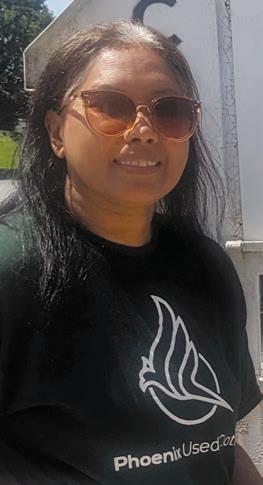


|Newark Life|
2025 UPCOMING EVENTS
Jump
2O23
Continued from Page 40
UPCOMING EVENTS
Fall Community Clean Up
Fall Community Clean up
Saturday, October 11 | 9AM-11AM
October 14 | 9AM-11 AM
City of Newark City Hall Municipal Building
City of Newark Municipal Building
Meals on Wheels The Ultimate Tailgate
Wednesday, October 22, 6PM-9PM
Newark Symphony Concert
October 22 | 8PM-10PM
The Grove at Delaware Park 777 Delaware Park Blvd.
Independence School
Halloween Party
Halloween Costume Party
Thursday, October 23 | 5:30PM-7:30PM
George Wilson Center
October 26 | 4PM-5:30PM
George Wilson Center
Halloween Parade & Trick or Treat
Sunday, October 26 | 3PM-5PM
Halloween Parade & Trick or Treat
Downtown Main Street
Turkey Trot
Handloff Park
October 29 | 3PM-5PM
Downtown Main Street
Saturday, November 22 | 9AM-11:30AM
Flags for Heroes
Nov 10 | 11 AM | Newark Reservoir
For donation form
Handmade Holiday Bazaar
Sunday, November 23 | 10AM-3PM
Aetna Firehall
https://nmrde.org/flags-for-heroes/
Turkey Trot
38th Annual Thanksgiving Day Breakfast
Saturday November 18 | 9AM-11:30AM
Thursday, November 27 | 8AM-10:30AM
Winterfest
Handloff Park
George Wilson Center
Thanksgiving Day Breakfast
Thursday November 23 | 8AM-10:30AM
Friday, December 5 | 6PM-8PM
George Wilson Center
Academy Building Lawn
Winterfest
Santa’s Secret Workshop
Friday December 1 | 6PM-8PM
Saturday, December 6 | 9AM-12PM
Academy Building Lawn
George Wilson Center
Santas Secret Workshop
Snack with Santa
14 22 26 29 10 18 23 1 2
Saturday December 2 | 9AM-11:30AM
Saturday, December 6 | 9AM-11:30AM
George Wilson Center
George Wilson Center

The First State An opportunity,
By Gabbie Burton Contributing Writer
No matter where you look these days it seems as though artificial intelligence is there to meet your gaze. From the mundane to the complex and from achievement to threat, AI has become an inescapable part of modern life. The only question left for humanity to answer is how should we use it?
The University of Delaware has an answer: For the greater good.
In early July of this year, the University of Delaware opened the First State AI Institute, an initiative to build a state-of-the-art AI infrastructure for the university to use in four key areas: research excellence, enhanced teaching and learning, optimized business operations and ethical AI leadership.
The Institute is located in the FinTech Innovation Hub on the Science, Technology and Advanced Research (STAR) Campus.
“[AI] is proliferating into literally every discipline,” said Prof. Sunita Chandrasekaran, the Institute’s director and associate professor in the Department of Computer and Information Sciences. “We have had a lot of demand for our services, and are still having demand from the faculty of almost every discipline.”
Chandrasekaran explained that in her ten years at the university, the demand for AI has increased rapidly over the last two to three years, showing an increased need for the university to invest in AI frameworks. Fortunately for the Institute, Chandrasekaran is well equipped to meet

the increased demand. In addition to her roles as director and assistant professor, she also leads a large grant by the National Science Foundation on Democratizing Access to Research Software Engineering (DARSE) and was co-director of the AI Center of Excellence.
“Prior to leading this institute, we had an AI Center of Excellence,” said Chandrasekaran. “As part of the Center of Excellence, we ran hackathons and worked with faculty, but suddenly in 2023-2024 timeframe, we saw this boost of need for AI, and we couldn’t keep up with the demand, which then led to the start of the Institute.”
The increased need for AI capabilities raised questions, including whether or not sensitive data sets from researchers at the university should be entered into third party AI vendors.
“These questions led us to wonder, ‘What if we pulled our own test bed infrastructure at UD? What if we built our own system so we can retain some of the sensitive data set within UD’s infrastructure, and still perform science and open research?” she said. “What if we took a copy of an existing tool but customized it towards faculty needs and their domain science, and found some answers? In the process, we will be doing new research.”
By having their own AI system, the university can safeguard sensitive data sets and personalize the system to best address UD’s unique faculty, student and operational needs including enrollment, finance, development and any other field as it arises. Further down the line, Chandrasekaran shared that she can envision the university working with outside partners, but the primary focus remains on the university’s work and needs.
State AI Institute: not a challenge
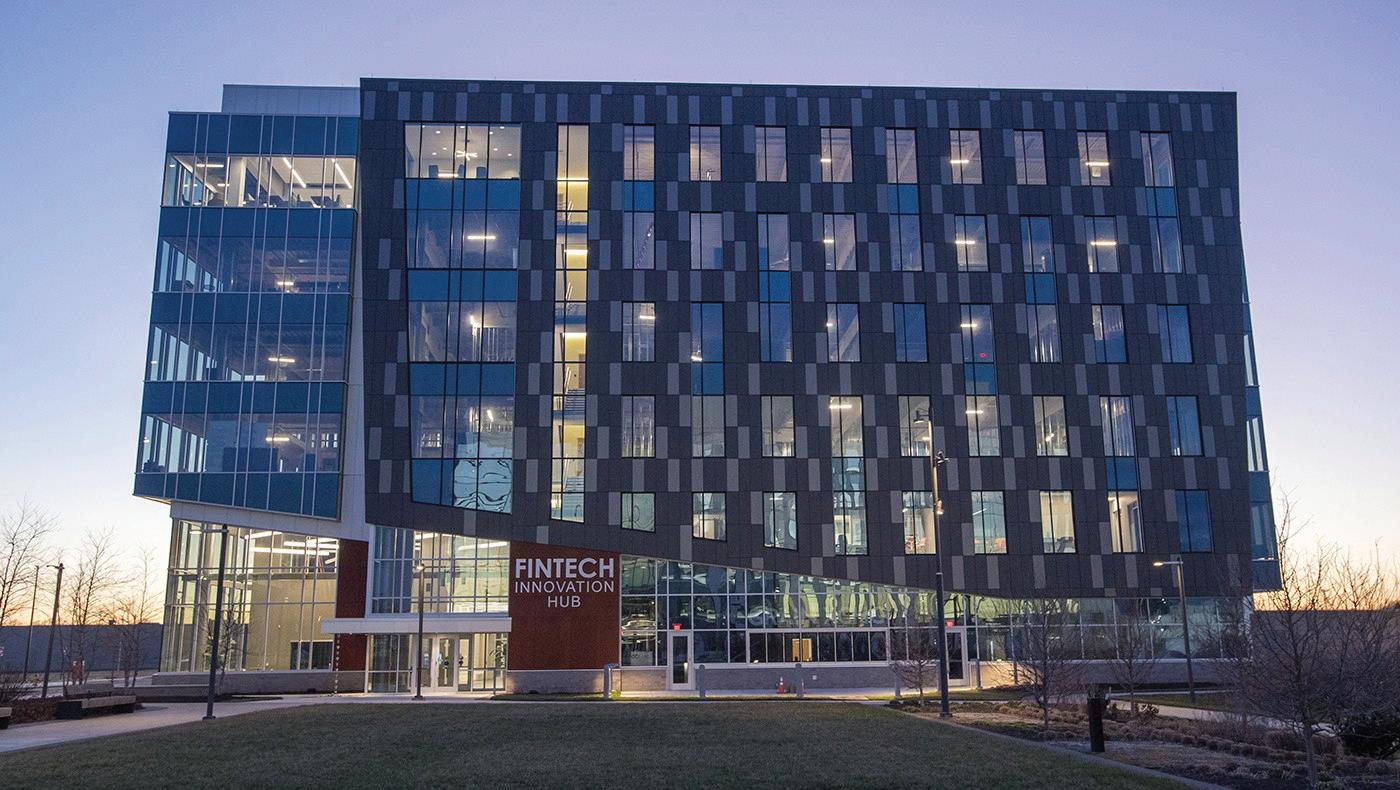
With this bold approach comes hard work, building the infrastructure, hardware and workforce to reach the goals of the Institute. Chandrasekaran explained that the Institute

is following a timeline and so far they are working on finding leads for their key areas, organizing working groups,
Continued on Page 44
Courtesy photo
The Institute is located in the FinTech Innovation Hub on the Science, Technology and Advanced Research at the University of Delaware’s (STAR) Campus.
The First State AI Institute
Continued from Page 43
gathering data, recruiting research software engineers and more. A main initiative the Institute took on over the summer was the hackathon, which Chandrasekaran said took up the entire month of August.
On top of all the logistical work that is going into building the Institute, there is still a looming concern Chandrasekaran and the whole Institute team must factor into the equation: the ethical complexities of AI and how best to mitigate them.
According to the Institute’s website, “the Institute’s research will advance an open, human-centered vision of AI — one rooted in transparency, accountability and the public good.” The work to ensure such a model of AI requires diligence from the very beginning.
“It’s been a constant concern,” said Chandrasekaran. “We are trying to make sure that the input data set is not biased. I think that’s where the main issue comes from. Once your data set is biased or ignoring a certain type of input, then your end result - your end model - is biased. Then you’re done, and you can no longer get a neutral model.”
While the Institute is not creating an AI model from scratch, they are retraining an already existing AI system to mitigate this preconceived bias.
“We get a copy of the already messed up model, but then we are retraining it with our own data set, where we can ensure that it is unbiased, and then we use the retrained model for inferences, for results,” she said. “There is some control, if not all of it, because you know what you train the model on.”
While Chandrasekaran and the Institute’s team are doing what they can to create a more ethical AI model, the same may not be true for all AI models. Chandrasekaran shared that the other piece to ethical AI is user knowledge and awareness.
“I think the user needs to know what the right answer is, and that’s the other problem, because half the time we don’t know,” she said. “It is a very tough problem to solve – to know how to create awareness within the community and not just blindly believe what the models give you. You need to have some sense of what the outcome should be, and

Next edition of Newark Life
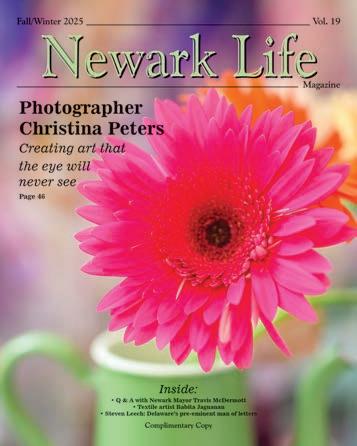
that’s an awareness we are trying to create internally.”
While the complexities of AI may never cease, and the First State AI Institute is still in the early stages of facing those complexities, Chandrasekaran and the team at the Institute are prioritizing a human and UD focused model. While there is still a lot of work coming up for the Institute, Chandrasekaran repeated a mantra that seemed to reflect her outlook on not only the work of the institute but the larger implications of AI:
“It is an opportunity, not a challenge.”
To learn more about the First State AI Institute at the University of Delaware, visit https://first-state-ai.udel. edu.



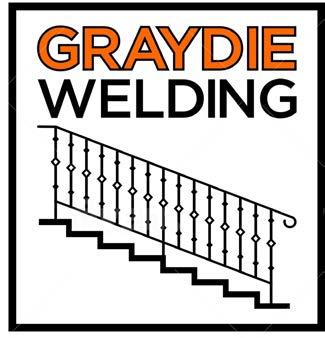


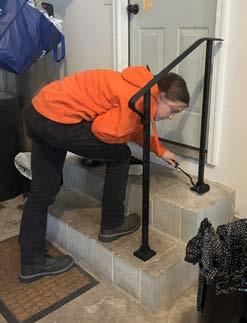

Courtesy photo
The team at the First State AI Institute at the University of Delaware, from left to right: Co-Principal Investigator John Huffman, CoPrincipal Investigator Rudi Eigenmann and Institute Director Sunita Chandrasekaran.
|Newark Life Photo Essay|

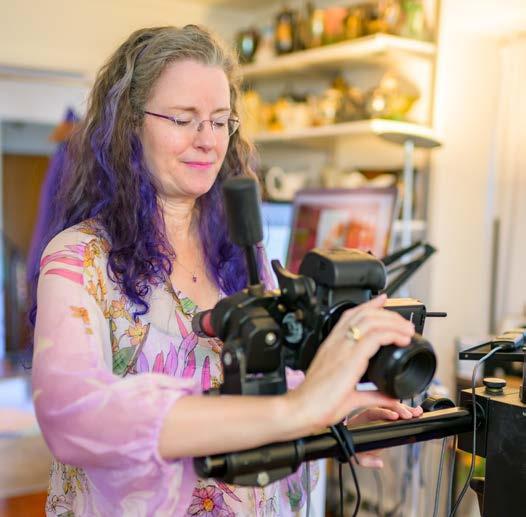
PHOTOS BY
Jim Coarse and Christina Peters
TEXT BY Richard L. Gaw




PHOTOGRAPHER CHRISTINA PETERS
Creating art that the eye will never see
When Christina Peters was eight years old and living in Newark, her father, a chemist, gave her a plastic camera. By the time she turned ten, he taught his daughter to properly use his Minolta XT 101.
Continued on Page 48
|Newark Life Photo Essay|

Continued from Page 47
“The meter was simple – all you had to do was make the circle cross through the line in the camera, and for a child, that was so easy to understand,” said Peters, a Newark resident who has been a commercial and food photographer for the past 30 years. “I didn’t know what all of the other numbers meant, but as long as the line crossed through the circle, that was all that I needed to know. We’d ship my film off to Kodak, and when I got the photos back, my photos looked horrible. They were not what I imagined what they were in my head. I was constantly trying to figure out how I can get the image in my mind through the camera.”
Every person’s creative journey has a beginning, and the story of how Peters’ passion for photography may have started with the plastic camera, but it is one that has been layered with a curiosity to learn more about answering that complicated question,
‘How do I get more of me in every photograph I take?’
Peters’ first photography class was at Shue Middle School with Mr. Brubaker, who allowed the young photographer to use his makeshift janitor’s closet as her darkroom. She kept her eye trained on Newark, working for the yearbook at Newark High School and then at the Newark Post. Eventually, she cracked the code that every good photographer begins to understand.
“I was working at Rainbow Records on Main Street, and one of my co-workers was in a band, and he needed some headshots. We went to the alleyway near the store, and I saw light coming through a window, and everything I had previously understood about photography had immediately shifted,” Peters said. “I saw lines and textures and shadows and highlights.
It taught me to look at photography differently. I then began to look at things as a compositional element, instead of just a scene.”
After receiving degrees from Cecil College and then the Art Center College of Design in Pasadena, Calif., Peters began her career as a commercial food and floral photographer and where, from her studio in nearby Glendale and later in Marina Del Rey, she flew all over the country working for several advertising agencies, while also developing her talent as a fine arts photographer. While in California, she also created a food photography club that saw hundreds of photographers go through the program.
“I tripped across my first account with a local grocery store,” Peters said. “They were hiring a new agency, and he was looking for a junior shooter. I began shooting every other week for the next five years, shooting every kind of food you can imagine.”
Since moving back to Newark with her hus-
band in 2020, Peters has shifted her focus from commercial photography to fine art photography, launching Christina Peters Fine Art, with particular emphasis placed in the area of floral imagery, which she sources from local flower farms whenever possible. Her photos are often seen at festivals and markets and are also showcased in several restaurants and cafes.
“On shoot day, my entire space is filled with flowers,” she said. “I make a shot list, determine what I want to shoot, and I will look at them through a lens and then place them in an arrangement. It’s just something that gets that dopamine going, because flowers certainly trigger all of our happy chemicals.
“The goal of the eye is to make everything in focus, but there are visuals that you can create with a camera lens that your eyes cannot, and that’s what I love about photography. It’s creating art that the eye will never see. It’s building a universe within that small frame.”
To learn more about Christina Peters, visit www.christinapetersfineart.com.

With one critically acclaimed film now available Newark-based filmmaker Bella Dontine is Her lion’s Her lion’s
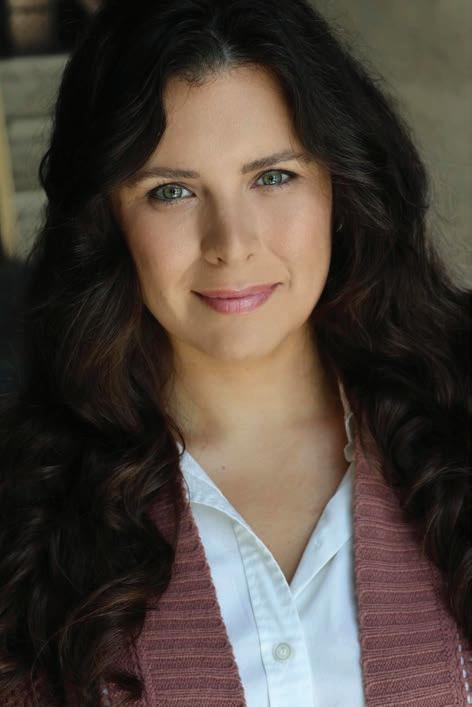
By Richard L. Gaw Staff Writer
INT. AUTUMN’S HOUSE – BEDROOM
– NIGHT
POUNDING ON THE FRONT DOOR, YOUNG AUTUMN BENNETT (12) jerks from sleep. Far faced, brunette, Autumn is a feisty intellectual.
From A Lion’s Game (2024), screenplay by Bella Dontine and Travis Brown
From the time she was a young child growing up in Wilmington, Bella Dontine’s life has been a tireless pursuit to find, confirm, solidify and protect her authentic self.
For the past three decades, her ‘to thine own self be true” journey has been clearly visible to anyone who wishes to see it: on stage in musicals throughout Delaware, as a singersongwriter on Instagram video snippets and most especially in films – her films, where she is a producer, actor and writer - the ones she has made with her creative collaborator Travis Brown, most recently A Lion’s Game (2024), for which she and Brown won three awards at the WRPN Women’s International Film Festival and earned a nomination for best film at the Montreal Independent Film Festival.
To witness Dontine portray the character of Autumn Bennett in the film is to witness a tangible strength that twists and turns with the tension of the script, and one that is defiantly juxtaposed with the shy young girl from Delaware who would not speak in front of strangers and took solace in the shadows.
Courtesy photos/images Newark filmmaker Bella Dontine.
available and another one in pre-production, is at the absolute center of her life’s story
game game
And yet, through that self-made cocoon of protection, the young girl saw the white glow of a portal coming off the television and movie screens of her childhood and chose to follow the stories in the light.
“I was painfully shy as a child, and when people would come up to me, I wouldn’t talk to them and I would hide from them,” Dontine said. “At about the same time, I began to fall in love with shows and music and movies, like old Judy Garland films and Beauty and the Beast. My mother took me to see an ice-skating show version of the film, and I remember being mesmerized at the sight of thousands of people enjoying what they were seeing.
“I was witnessing something magical happening in that arena, and I wanted to be with the performers and step into a character’s shoes rather than be in mine,” added Dontine, who started dance lessons at the age of two, and when she turned six years old, started performing in school theater and at the age of nine she landed the lead role of Mary Magdalene in a Christmas production of Mary & Joseph. “When I was 12 years old, I was performing at the Candlelight Theatre in Arden, and my grandfather saw me and said that he was shocked to see his granddaughter on stage, projecting her voice to the farthest reaches of the theater. ‘Is this the same girl I know?’ he asked.
“I found that I was able to express myself through art. I felt like I was releasing something while still having the freedom to hide. I know that I wouldn’t have the courage to go out and speak for myself, but I was able to do so through the characters I was portraying.”
Continued on Page 52

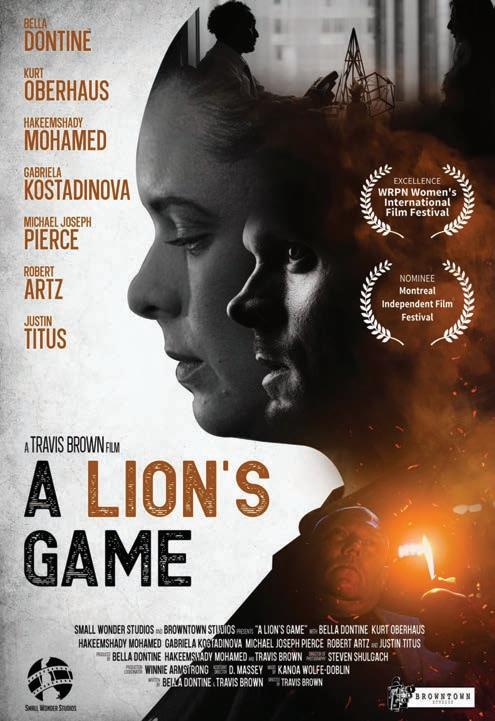
Dontine co-wrote, produced and starred in A Lion’s Game, which was released on April 22 and was distributed by Gravitas Ventures.
A Lion’s Game received an award at the WRPN Women’s International Film Festival.
Bella Dontine
Continued from Page 51
Before she was old enough to drive, Dontine had already become an unstoppable force, auditioning and rehearsing and performing on stages throughout Delaware and beyond. She began dancing competitively and also took singing, guitar and piano lessons. She performed at Walt Disney World and Planet Hollywood in New York City, and took dance classes with Broadway performers and at Steps on Broadway. To accommodate her busy schedule, she was home-schooled during her junior and senior years of high school.
“When so many other people my age were out on weekends and dating, I did none of that,” she said. “I was working as much as six days a week as a dancer and an actor, because I made the decision not to give myself any other choice. My sole focus since I was about two years old has been to find opportunities and connections.”
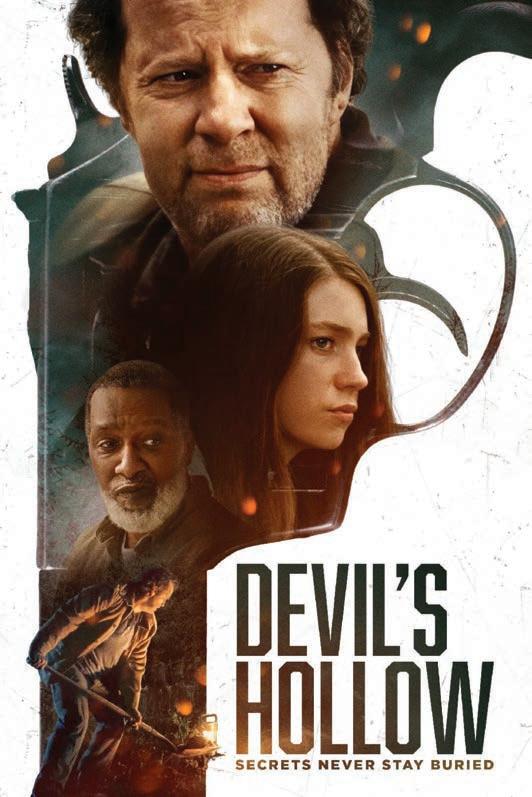
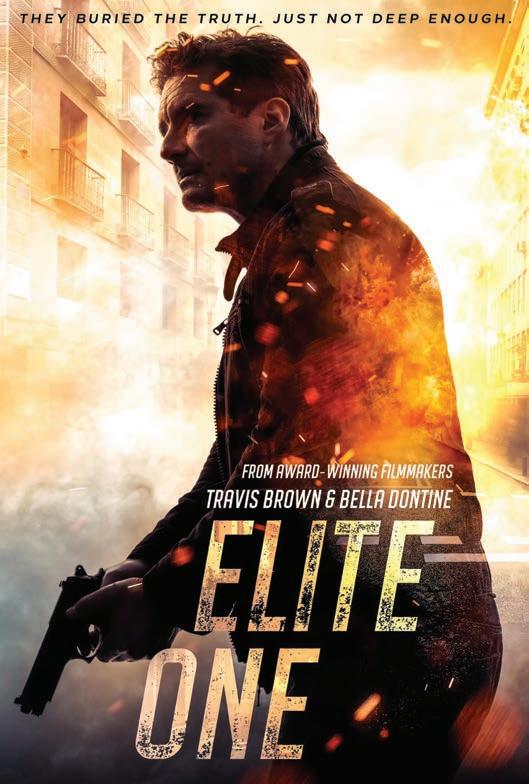
EXT. PARK – DAY
RUNNING FEET of Young Autumn and Young Michael transition into the RUNNING FEET of an older AUTUMN BENNETT (26) and MICHAEL WEST (26) running together. Autumn and Michael stop for a breather. Autumn removes her phone, observes an incoming text, then immediately puts the phone away, shaking her head in frustration.
By the time she entered Wilmington University as a digital filmmaking major, Dontine was fully illuminated by the portal she willingly chose to enter. There, she found a creative partner in Travis Brown, who was pursuing a degree in studio production. Together, they made their first film, The Average Guy – Dontine had the lead role - and then another film. She continued working on and acting in short films in college and went on to receive her master’s degree. Within the span of a few years, Dontine’s trajectory had skyrocketed from merely dreaming to actually doing.
Continued on Page 54
In collaboration with her creative partner Travis Brown, Dontine produced the film Devil’s Hollow and they are now in pre-production for the latest film, Elite One

Bella Dontine
Continued from Page 52
“After we graduated, Travis had left Delaware to Los Angeles, and for a time, we had lost touch,” she said. “Then he reconnected with me and asked me to be a part of a film he was working on called Norwalk Witness. I flew out to LA and filmed it, and ever since then, we have been creative partners, and our working relationship just continues to grow. We have a very similar vision in terms of where we want our careers to take us. We both have the same drive, and that lends itself well to our focus as partners.”
In 2017, Dontine moved to California and worked with Brown on five screenplays, and in 2021, they released their first feature film, Devil’s Hollow, which earned serious buzz at its West Coast premiere at Grauman’s Chinese Theatre on Hollywood Boulevard and later received high praise at Louisville’s International Festival of Film, the Golden State Film Festival and the SOHO International Film Festival, among others.
KAREN BENNETT
Don’t you dare shed a tear. Life is not fair. If you cave in and start getting all soft and mushy it’s going to swallow you up. You always gotta have a way out. Always be one step ahead. Whatever it takes, I never want you to end up like your father and I, broke and begging for crumbs from the master’s table. Do you understand me, Autumn?
When Dontine and Brown first began to set down the ideas for the screenplay that became A Lion’s Game, they wanted to create compelling characters and, in an effort to conserve the film’s budget, place them in scenarios that did not involve elaborate sets and costly technical bells and whistles. Armed with a $20,000 budget, a small cast and crew and Dontine in the lead role of Autumn, shooting took place mostly in Los Angeles in September of 2021.
“The set was chaotic at times, because we didn’t always have a full crew because we didn’t always have the money to pay them, so I was often the assistant director,” she said. “We would go to a location, unpack everything, and then I had to learn my lines for the day and get the call sheets ready for the next shoot.
“One day, we had a few assistants call out, so we had to get food for the cast and crew. This experience taught me that there are people counting on you, so I have to keep a positive attitude. One night, we were filming at three in the morning, and I was so exhausted that I had to slap my face in order to get ready for a scene.”
Complications with the sound required an additional
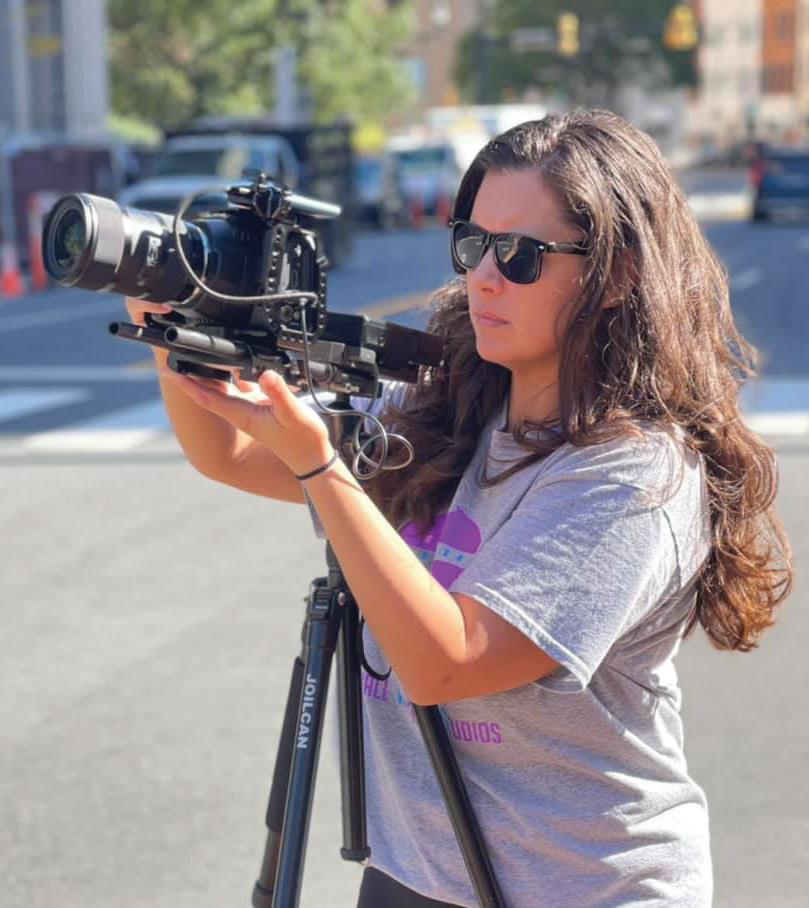
$20,000 for the budget, and after post-production was completed, Dontine and Brown sent A Lion’s Game to as many distributors as they could. Gravitas Ventures, a major independent film distributor, took on the project and on April 22, 2025, the film was released.
In addition to the awards the film garnered at film festivals, it became available on Apple TV, Amazon Prime, Comcast and Fios, and all of a sudden, the shy little girl who hid behind the clothing and the shoes and the makeup of her characters was now front and center and beaming into thousands of homes.
Earlier this year, Dontine and Brown announced they were working on developing their next film entitled Elite One that once it secures a budget, is expected to be filmed on the East Coast.
Continued on Page 56
Dontine developed her filmmaking skills at Wilmington University.
ChesterCounty PRESS
Serving the Chester County business community since 1866 Your source for local news, government, schools, sports and much more! Published every Wednesday. To subscribe call 610-869-5553 ext 10.
LIFE MAGAZINES
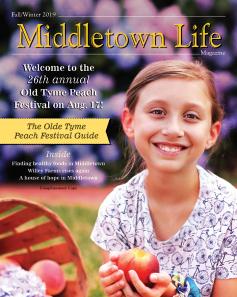
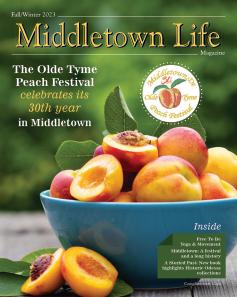
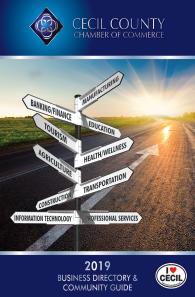
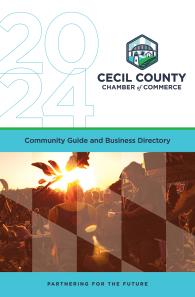
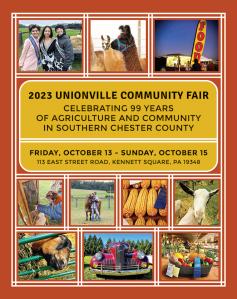
• Landenberg Life • Kennett Square Life
• Chadds Ford Life • Newark Life
• Middletown Life • Cecil County Life
• Greenville & Hockessin Life
Each of our Life magazines offer “hyper local” news from each community in the form of features, proles, history, entertainment and home and garden stories. Our “coffee table “ keepsake format with extensive direct mail appeals to a wide variety of advertisers
CHAMBER OF COMMERCE PUBLISHING
• Southern Chester County Chamber of Commerce CONNECTIONS
• Western Chester County Life
• The Oxfordian
• Cecil County Chamber of Commerce
Annual Business Directory
• Exton Region Chamber CROSSROADS
Custom tailored magazines that are essential for your local Chamber of Commerce and business community.
EVENT & SPECIALTY PUBLISHING
• Mushroom Festival & Visitors Guide
• Unionville Community Fair and Farm Show
• Kennett Run Event Guide
• Middletown Peach Festival
• Penn Township Newsletter
• Mushroom Cap Half Marathon Guide www.chestercounty.com
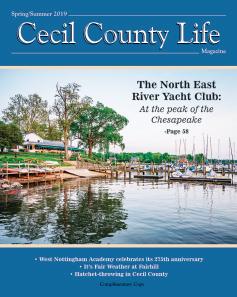
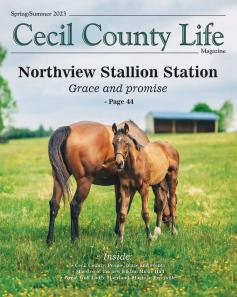
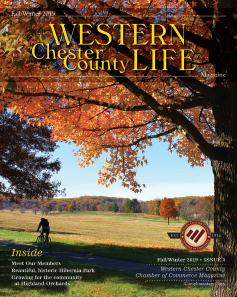

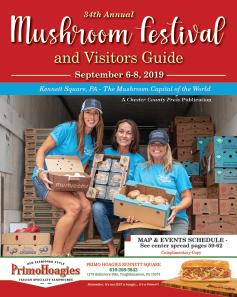

Bella Dontine
Continued from Page 54
It can be said that the world of filmmaking – particularly for a young auteur like Dontine – can be ruthless, unforgiving, like a bolt that is impossible to unlock.
Rejection waits at every corner.
All of the accent marks are placed not on one’s talent but on one’s ability to self-promote.
Great screenplays don’t count for as much as the number of social media followers a filmmaker has.
“Being on the outside and having to fight and claw my way in is frustrating, but I am the victim of my own tunnel vision,” said Dontine, who began her filmmaking company Small Wonder Studios in 2015. “This is all I have ever seen myself doing. I have tried other things, but nothing fills me the way that

filmmaking and storytelling do. A lot of people are willing to give up their dreams just for a paycheck and the security of benefits. Of course I want that, too, but I am more afraid of being on my deathbed and asking, ‘I wonder what could have happened if I truly pursued my dreams?’ That terrifies me.
“To this day, I’ve never been to therapy. I have just found my empowerment through my desire to create, to take people away from the world a little while and tell them a great story.
“My younger self would be very proud of me right now.”
In 2015, Dontine founded her film production company Small Wonder Studios.
To contact Staff Writer Richard L. Gaw, email rgaw@chestercounty. com.


NEWARK MAYOR TRAVIS MCDERMOTT
Over his long and distinguished career with the New Castle County Division of Police – where he is now a Senior Lieutenant – and his time on Newark City Council, Travis McDermott has made his mark as a public official. On April 17, he took on his largest role yet as Newark’s newest mayor. Recently, Newark Life met with Travis to discuss what he sees as the City’s top priorities, his longterm vision for Newark and his very unique dinner party guest list.
Newark Life: You served on Newark City Council for five years, were Deputy Mayor since 2021, and on April 17, you were sworn in as the Mayor of Newark for a threeyear term, so you are more than qualified to answer the following question: In your opinion, what is the top priority for the City of Newark moving forward?
McDermott: There are multiple priorities - shorter priorities that need to be taken care of in the immediate future and then there are longer term priorities - but for 2026, our top priority will be the review of our comprehensive development plan. When we talk about things within the city - housing, property taxes, revenue – they all relate to each other, so the comprehensive development plan which will allow us to determine what our city will look like for the next ten years, and determine how we want to develop, what type of housing we want to develop, where we want to develop, and determine what that will do for affordable housing and workforce housing.
Our comprehensive development plan will be our roadmap to how we want to get to where we want to be on each of those issues over the next ten years. Throughout 2026, we will get the public input and find out what our residents truly want. We hear from a lot of lobbyists. We hear from Dover or hear from interest groups about what they want to see, but what do the residents want? To me, that is most important as we move forward with our comprehensive development plan.
Among the many responsibilities that come with being a mayor, the one that consistently appears on the pile is in creating long-term financial stability. What measures are being taken to ensure that the financial picture of Newark is a sound one?
Essentially, the City of Newark is a utility company, so we make the vast majority of our revenue through the sale of water and electricity, so if we have a hot summer, we do okay and if we have a mild summer, we have a budget problem. So how do we stabilize that? Balancing a budget on a revenue that is fluctuating is difficult. We have implemented customer charges - a fixed rate that everyone pays. I made it my point over the last two years on Council to lobby and push to get a University of Delaware student tax through, but none of these initiatives are the silver bullet for our budget. When we try to project out for the next five years, a key part of that will be determining how we manage our electric and water rates over the next five years to make sure that we don’t get to a point where we are so behind the curve on infrastructure and behind the curve on what it costs. We hired a consultant to develop an electric rate report to help us determine how much we should be spending on our infrastructure, what we should be charging and what our rate increase should look like over the next five years. We plan to implement the recommendations of tht report, so that we have an outline.
We also rely on parking as a way to generate revenue. I don’t think that it is beneficial for businesses, but it’s a reality and we make about $4.5 million every year on a $124 million annual budget. So how do we get away from that? A long-term strategy would be to change our parking focus to parking management and not revenue, and that is where we truly should be at.
The University of Delaware currently enjoys a taxexempt status, which results in a loss of approximately $6.5 million annually in property taxes for Newark. How
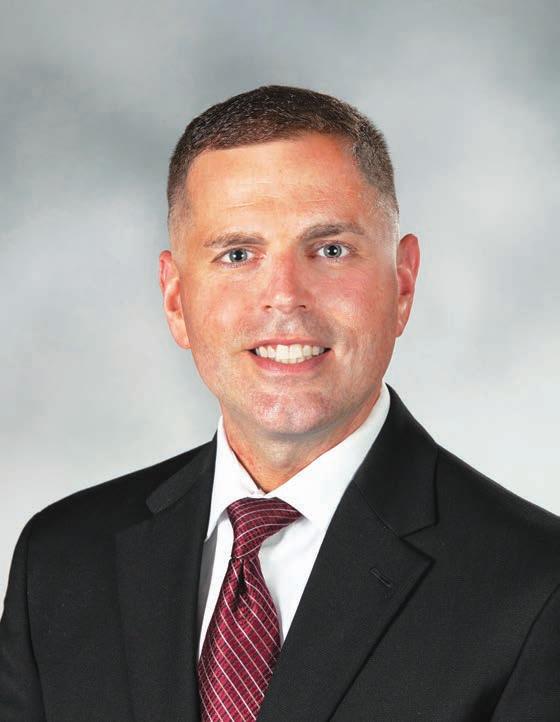
are you addressing this shortfall? Have you found a new revenue stream for the city?
When they first implemented this, the University wasn’t even in Newark. When I first joined Council, I started looking at budgets and year after year, I was told, ‘You don’t want to make the University mad.’ But year after year, I said that the University is using a credit card to pay for utilities, but I kept being told that the City of Newark and the University have to work well together. I said that we can work well together, but there has to be a benefit to both parties, not just a onesided benefit where the University gets $165 million from the state, which is more than our entire budget.
I said that I am not trying to fight the University but simply highlighting the facts – that we are losing more than $6.5 million in lost property taxes. In the first year I got zero traction, but eventually, it became hard to fight the facts, and finally, the University acquiesced, and we moved forward with the student tax, which generates about $2.4 million for the City of Newark.
How would you assess the relationship between the University of Delaware and the residents of Newark?
There is always a lot of talk that points to a contentious relationship between the University and the City, but I don’t find that. Are there issues that we don’t agree on? Yes, but
99 percent of the functions that the University and the City do together run flawlessly. Our police departments and our public works departments work great together. There are no issues between the City’s government and the governing body of the University. Do we agree on everything?
Absolutely not. Is student sprawl a real thing and is it encroaching on our traditional residential neighborhoods? One hundred percent. Should we take measures to try and stop that? Absolutely.
I don’t think that the University is opposed to these issues.
What first inspired you to enter public service? Was there a crystallizing moment or has this been marinating over a long period of time?
As a police officer, I have been in public service for my entire life. I have always liked government. I was a political science major at the University of Delaware, but as a police officer, I found that there are limited public offices that one can hold. You can’t be a state representative, a state senator and you can’t be in the legislative body and the executive body at the same time. I spoke with former mayor Jerry Clifton, who told me to consider running for City Council, and I thought that this could be a possibility to be a part of the City’s government.
Photo by Eric Crossan
Newark Mayor Travis McDermott
Newark Life Q & A
In 2020, there was a political shift against police across the country calling for the de-funding of the police, and I felt that these were unjust attacks against the profession, because the men and women I work with on a daily basis are good people. I felt that they were being vilified, and I didn’t want to see that happen here. I realized that if I have a chance to speak up and protect this profession, maybe I could do it on City Council.
After graduating from the University of Delaware, you began your career as a youth rehabilitation specialist at the Ferris School in Wilmington. What did that experience teach you about the realities that often surround incarcerated youth and the reasons they are placed there?
It was one of the greatest and worst experiences of my entire life, all at the same time. I was 21 years old and graduated from the University and placed in the youth detention facility as a counselor and told to fix these kids. I gave it one hundred and twenty percent. They were just kids – 14 and 15
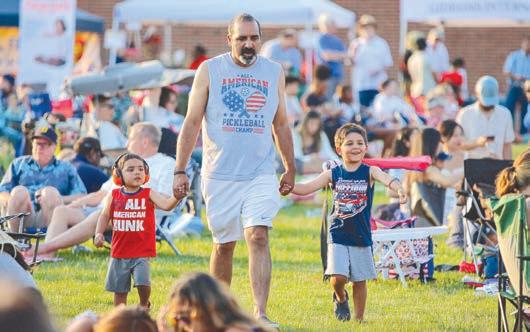
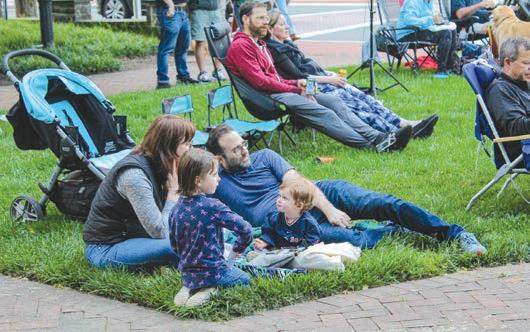
years old - and they were hardened and lacked social skills to navigate the world, and as they were placed in a structured environment, I began to see them change and grow. In my head, I thought that I had done my job. Years later, as I entered law enforcement, I kept track of them. I had a total of nine kids throughout my tenure, and today, all but one is either dead or in jail.
They all had hope in their eyes when they left Ferris, but when they were let out, they went back to the same environment they came from.
One day, I was in uniform in Dover for training, and a guy came up to me and ask me, “Are you Mr. McDermott?” He told me his name and said that I was his counselor at Ferris, and that I was the one who saved his life, and that he now owns his own contracting business.
You have had a long career as a member of the New Castle County Division of Police and are now a Senior Lieutenant, which again qualifies you to talk about a key issue of concern for many of your constituents. Under your direction, what initiatives are being undertaken to better ensure the safety of the residents of Newark?
In the short-term, Newark is making investments in technology and traffic safety, continuing to enact measures to keep our gun crime down, and continuing to conduct police community outreach.
For 2026, I have made it an issue that if the state can do one thing to assist the City of Newark in saving lives, it will be tackling the issue of people fleeing from the police. Within the city limits over the last year, we have had two deaths. One student had his back broken from a vehicle fleeing the police. Two people in a vehicle struck the St. John’s Church, causing hundreds of thousands of dollars of damage. On Route 273, a mother and daughter were killed by someone fleeing the police. What is being done about this? I am working with State Rep. Cyndie Romer to see what we can do to strengthen laws related to fleeing police. There really needs to be a change in how we view this crime and the punishments that go along with it.
There is not a mayor anywhere who does not have projects and initiatives that have a special and personal significance to him or her, and very often, those projects become lasting reminders of their legacy as mayor. What are yours?
When I look down Main Street, I see wholesale improvements that we can make there, starting with safety. We have made short-term measures to protect residents and students, but we cannot stop there. We need to transform Main Street
Photos courtesy of the City of Newark
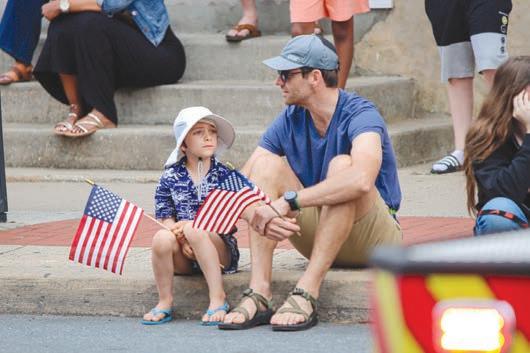
into a destination, which will require a complete revamping of our parking strategy. I want to remove on-street parking and create centralized parking that will allow people to easily walk along Main Street. I want to remove the on-street parking spots and extend the width of the sidewalks into those parking spots to create a larger pedestrian walking area.
I would like to bury the power lines along Main Street and put up the barriers, the pillars and planters to protect our pedestrians – to create a beautification of Main Street where people feel safe, and where restaurants will be able to
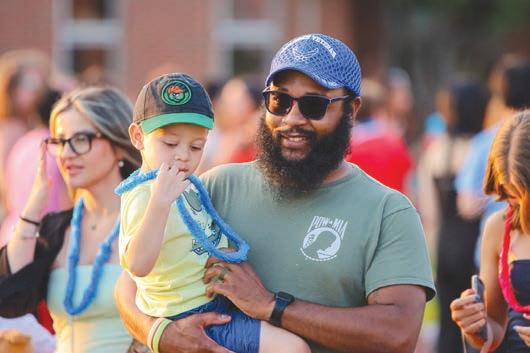
expand to the sidewalks. That’s the long-term goal; if I can get the City on that trajectory, then I will have accomplished something.
What is your favorite place in Newark?
My favorite place is Redd Park, along the trails that back up to the reservoir. This is my Zen, where I can get clarity of thought. It’s where I do all of my thinking. It’s where I debate everything in my head as I run or walk there. Unless it’s absolutely freezing, I walk those trails every single day.
Continued on Page 62

Continued from Page 61
Newark is beautiful. It’s not just the networks of trails where you can bike, walk or run, but it has Main Street. You can go to the movies. You can get ice cream at five different places. You can enjoy great food at a number of restaurants. This city is awesome.
You organize a dinner party and can invite anyone you wish – famous or not, living or not. Who would you want to see around that table?
People can interpret this one way or another, but my first choice would be Genghis Khan. Taking away the millions of people whose deaths he was responsible for, he was a political strategist who was able to unite nomadic tribes, he implemented religious freedoms and created written laws for his empire. While I do not necessarily agree with everything he did, I would like to talk with him to get his perspective.
I would also like to invite Jimmy Buffet, someone whose life was not as easy as he portrayed it. There was no way he sat on the beach every day, but he was able to put this façade out that he sat on the beach all day drinking pina
encourage local organizations, schools, civic and fraternal groups and churches to submit news releases.
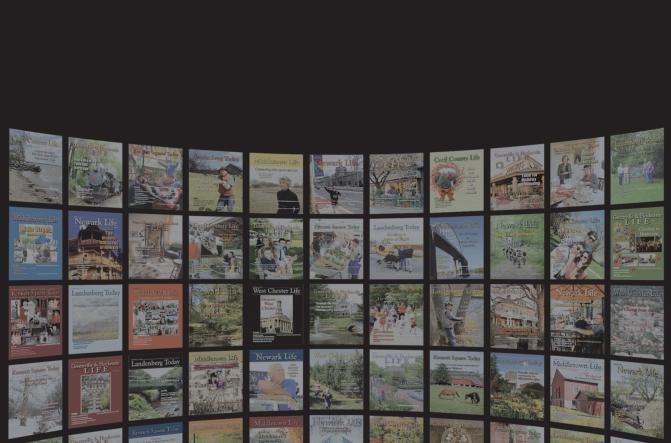


coladas. He portrayed the lifestyle that many of want to live, but he was a businessman, and no successful businessman sits on the beach all day long.
My third guest would be my maternal grandmother, who died when I was five years old. Hers was an American story. She was from West Virginia and married my grandfather, who was from Yugoslavia and became a coal miner. A lot of themes that occurred in her family are still common themes of the American experience today. I would like to get her perspective, because maybe it would be a perspective that I could apply to my life today.
What item can always be found in your refrigerator?
Cheese. I throw a wine and cheese party every year. I make everyone bring wine and a cheese to pair with the wine, and there is always way more cheese remaining than wine at the end, and I get to keep the cheese. The cheese that I really love is Trader Joe’s blueberry goat cheese. I could eat this cheese every single day.
- Richard L. Gaw


